Things to do in Kyrgyzstan
Things to do in Kyrgyzstan when you visit and travel around
Kyrgyzstan is one of the undiscovered places that mass tourism has not yet touched and where one can really still experience adventure just by taking few steps outside. Most people think that Kyrgyzstan is only about yurts, horses and mountain pastures (which are really worth seeing anyways and we will still tell you about them!) but it also has a lot more to offer! There are hundreds of hidden mountain lakes and rivers with waterfalls expecting to be found and valleys with breathtaking views and the ruins of silk road cities are just the beginning. The nomadic culture is still very much alive in Kyrgyzstan and the locals are eager to show it to anyone interested in it.
We hope that this guide of Kyrgyzstan’s highlights will inspire you to travel to Kyrgyzstan and to explore the off the beaten path mysteries that are surprisingly easily accessible. We believe that this is the most comprehensive guide on what to do in Kyrgyzstan! Kyrgyzstan is best enjoyed as a part of our Kyrgyzstan Tours or Central Asia Tours.
First things to do in Kyrgyzstan
Sleep in a Kyrgyz yurt and learn how to build a one
Yurt is the iconic sight of Kyrgyzstan and it is even featured in the center of the Kyrgyz flag. Once in Kyrgyzstan, be sure to stay in a yurt. Once inside you will notice that they have nice very soft acoustics and it is hard to determine from where someone’s speech is coming inside a yurt due to the round shape of it. When traveling in Kyrgyzstan you will notice yurts everywhere in the summer pastures, by the roads and even in people’s backyards.
Yurt is a simple yet ingenious mobile home that is warm enough and spacious but still easy to construct and move around fairly quickly. It is one of the single most important parts of the Kyrgyz nomad lifestyle and arguably one of the reasons why the culture still so lively exists to this day. Without the yurt, life would be very hard on the steppes and mountains of Central Asia.
Staying in a yurt is really fun and interesting and the tourist versions are mostly fitted with beds but the traditional way would be sleeping on the ground on top of some thick felts. Yurts are actually super comfortable to sleep in and it really gives the atmosphere of being somewhere far far away waking up to the sounds of horses walking outside your yurt in the high summer pasture during the cool early morning hours when the sun is rising.
If you plan on staying in a yurt, be aware that Kyrgyz people quite often burn coal to keep them warm. If you’re opposed to this, be sure to mention it. The other and more natural option is to burn dried dung which is also the only fuel available in the remote high pastures due to lack of wood.
In order to build your own yurt, you should head for example to Issyk Kul south shore where yurts are being produced. Yurt construction can be also included in any of our Kyrgyzstan tours on request.
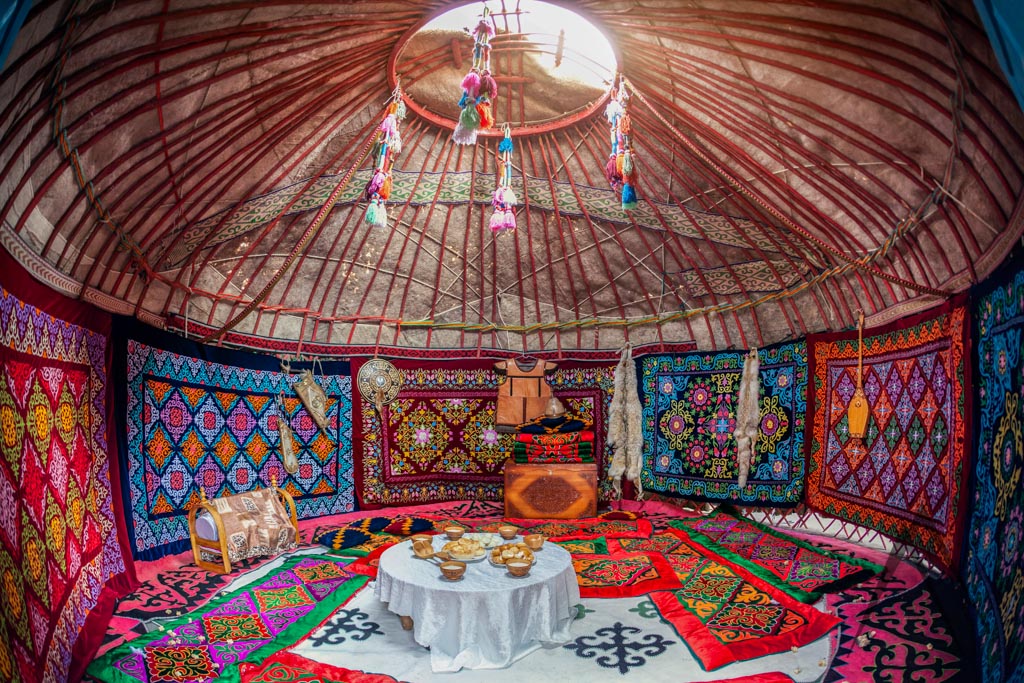
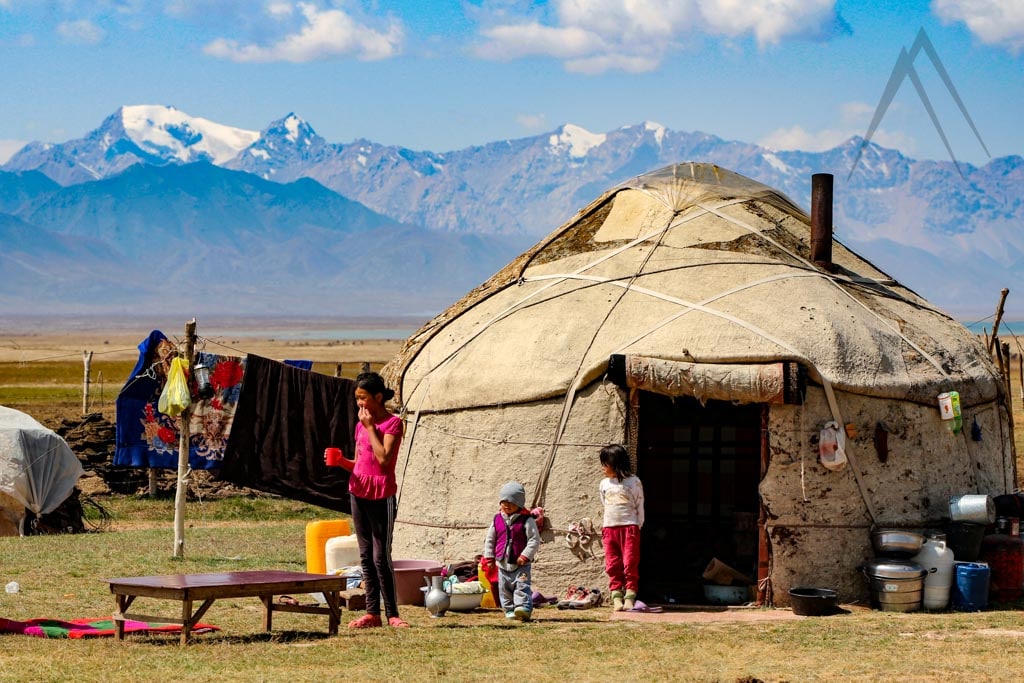
Try horse riding or horse trekking
In current Kyrgyz culture, the horse is still just as important as the yurt. Horses have many roles in Kyrgyzstan: transportation, provider of milk and meat, friend and companion and a partner in horse games. Without a horse, a nomad would be almost nothing. Horse based tourism is also providing for the horse culture.
While in Kyrgyzstan, it is very hard not to ride a horse (unless you really do not want to), even if you have never done so before. Kyrgyz horses are usually very well trained and their masters are very good at making new riders feel comfortable with good instructions and proper equipment. Kyrgyz horses are also not very big and are well adapted to the varying landscapes.
There are countless great horse treks in Kyrgyzstan and some of the most popular ones are the horse trails around Jyrgalan and other locations around Issyk Kul, Song Kul and Sary Chelek. In addition to the ready planned tours, it is possible to organize a horse trek almost anywhere in Kyrgyzstan and the prices are fairly affordable.
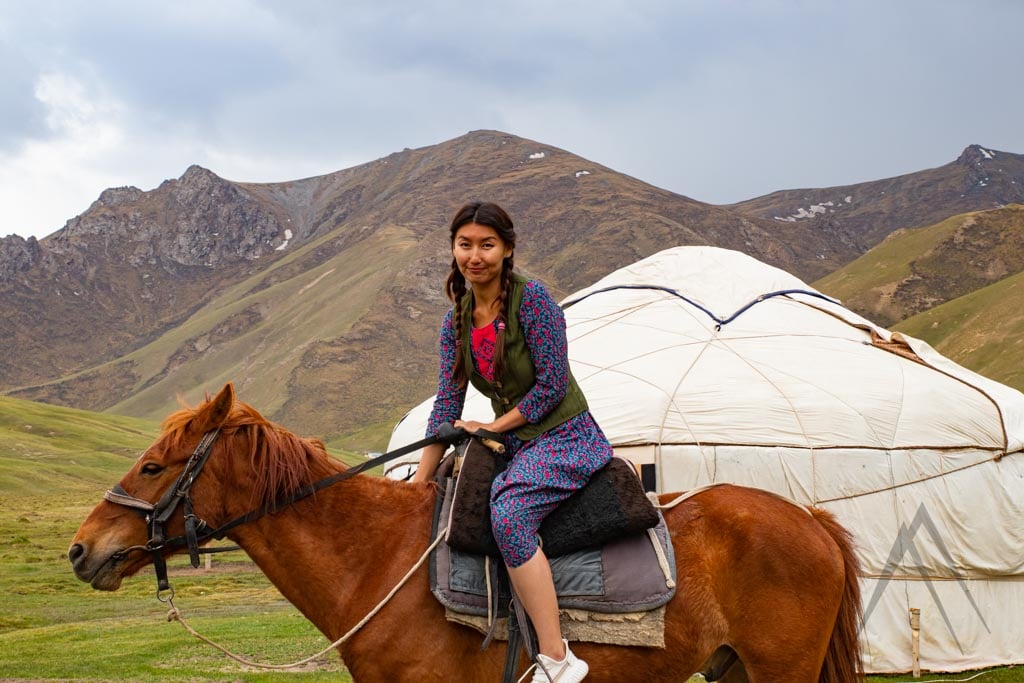
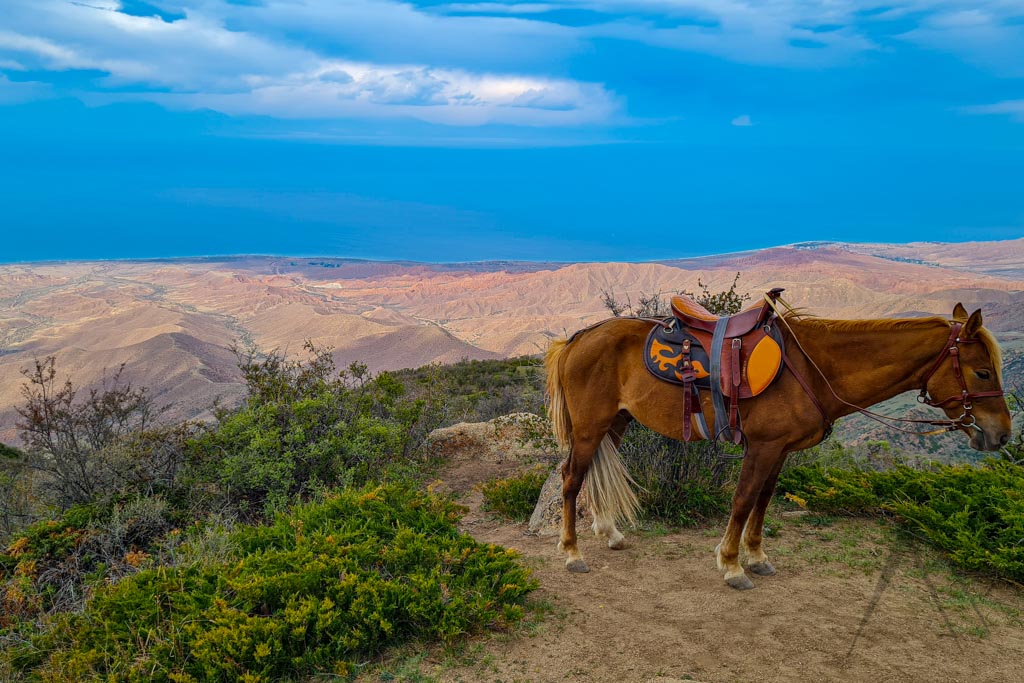
Visit Son Kul Alpine lake
Son (Song) Kul lake is situated at the altitude of 3016 meters, is the second largest lake in Kyrgyzstan and definitely one of the most beautiful. Son Kul is an alpine lake that is only free from snow in the beginning of June and is so high that there are no trees at all growing in the valley around it. There is also only one permanent building in the whole valley and that is an old grave monument. All the other dwellings are either mobile homes on wheels but mostly yurts. All the other The valley is surrounded by snow capped mountains that look small from the lake but don’t forget that the starting point is already more than 3 km!
Son Kul can be reached within 4-5 hours from Bishkek by a 4-wheel drive vehicle. It means that you can even travel there the day that you arrive Bishkek. The real reason to come to Song Kul is to experience the silence and simplicity of nature and to notice that it is unnecessary to carry your phone when there is no cellular network at all (unless you take your photos with your phone).
Son Kul is also a great place to try horse trekking around the lake and to explore the nomad life of the locals living in their yurts and taking care of their herds of animals and there is basically no other option than to sleep in a yurt. That being said there are various levels of comfort in the yurts available from sleeping on the ground (with felts) to having your indoor water toilet and shower and everything in between.
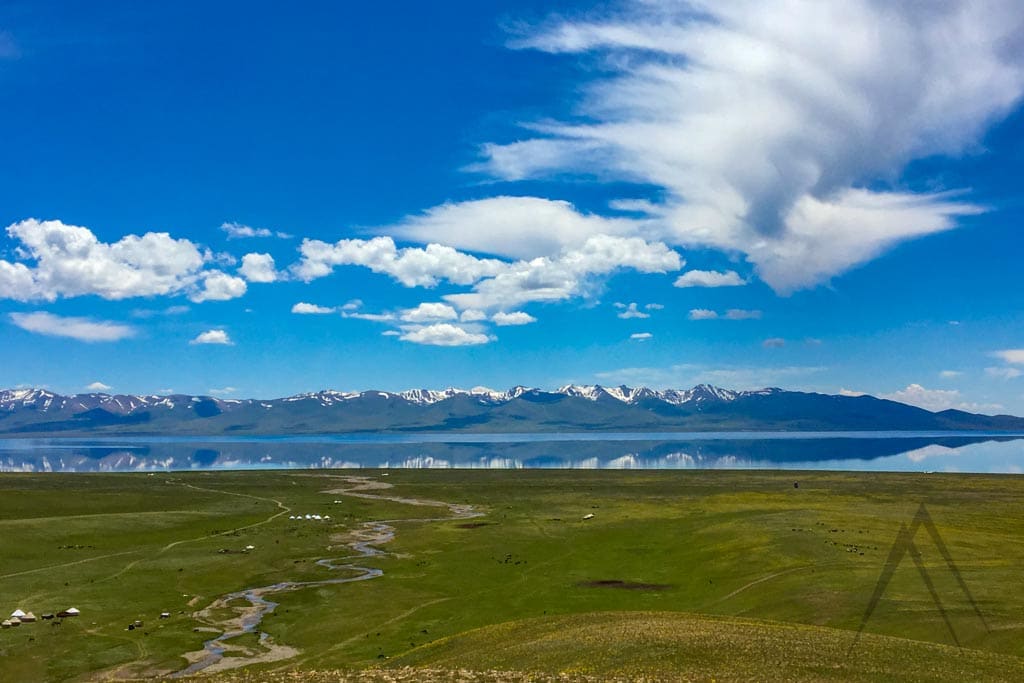
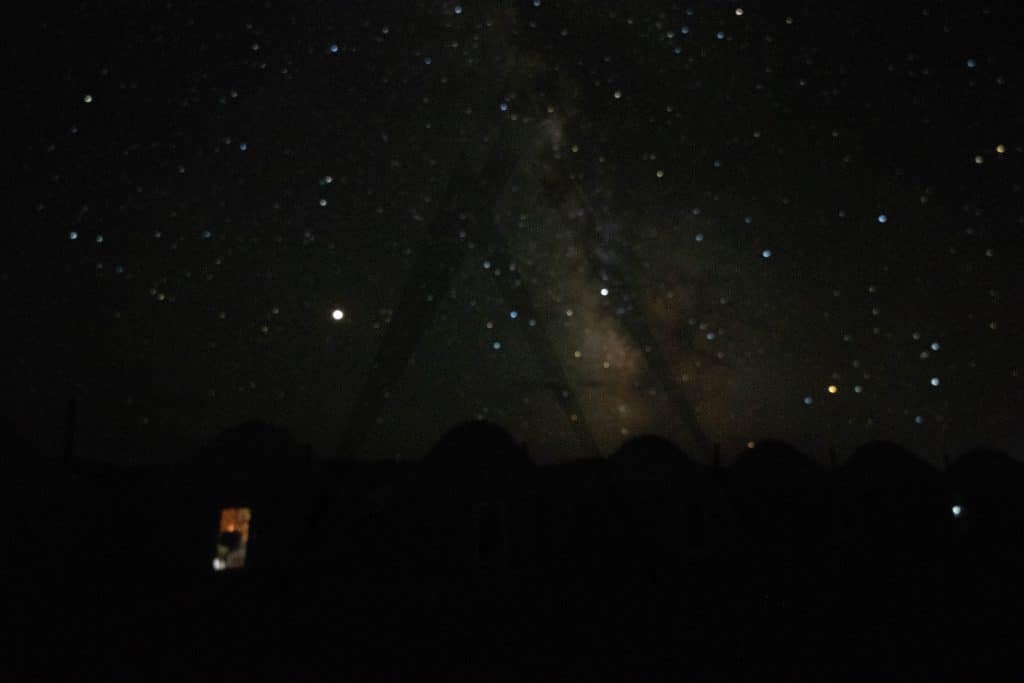
See the Kyrgyz nomad games
Kyrgyzstan is without a doubt one of the countries with the most alive nomadic cultures. Many Kyrgyz are very proud of their nomad ancestors and the old nomad games from the more nomadic eras are still played. The most known nomadic games are the Alysh belt wrestling, Er Enish horse wrestling, Chuko bone throwing and of course the infamous Ulak Tartysh (or Kok Boru) headless goat game. Most Central Asian countries have the same or very similar games as well but their names might differ.
Alysh reminds judo as the goal is to throw the opponent to the ground by holding on to his belt at all times. Er Enish (or Oodarysh) is wrestling whilst riding on a horse and the goal is of course to try to dismantle your opponent. Chuko bone throwing is like a slightly raw way of playing with marbles.
Kok-boru is a rough game that resembles polo with the two teams fighting over a dead headless carcass of a goat. In some international competitions, a fake goat has been used lately though. Two teams of horse riders fight over the body of a dead goat and try to throw it into a large hole at the opponent’s side that acts as a goal. Koko Boru is also Kyrgyzstan’s national horse game. It is one of the most popular sports in the whole Central Asia and has national and international yearly played leagues. The Kyrgyz national league early in the spring time when the air is still cool enough for the horses. In the summer times Kok Boru and other horse games are often part of some festivities or events.
If this sport is a bit too much for you, there are also other horse games that you can attend. For example At Chabysh is a long distance race for young boys, Kyz Kumay is a game where a young man is trying to catch a girl and to kiss her while riding (The girl is allowed to defend herself with a whip!) and Tiyin Enmey which is a game where the rider has to pick up a bag of coins from the ground while riding at full speed.
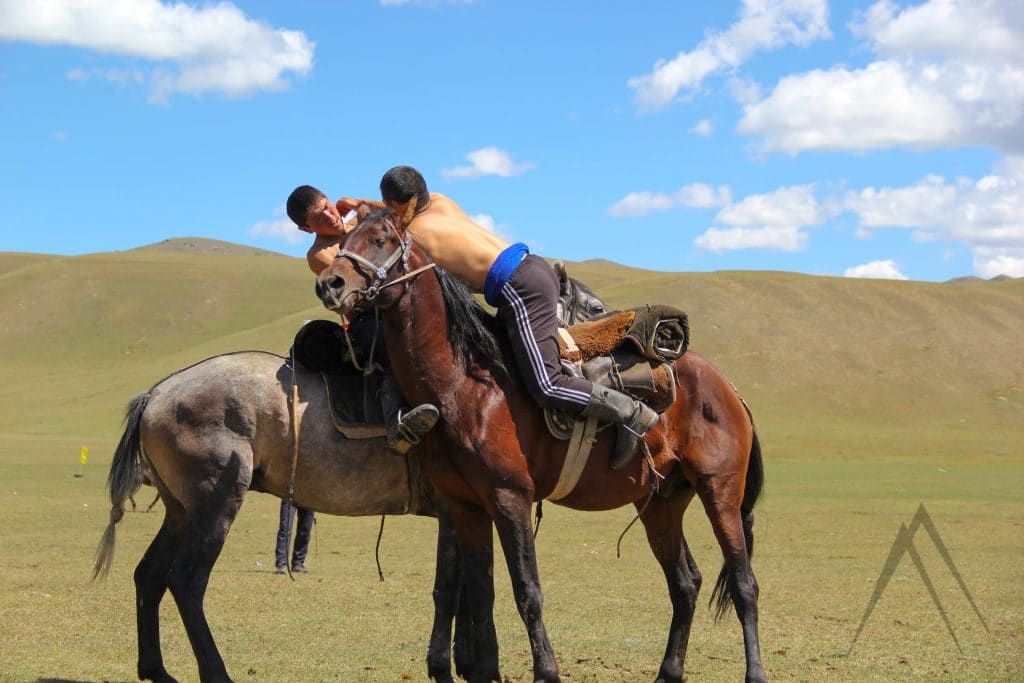
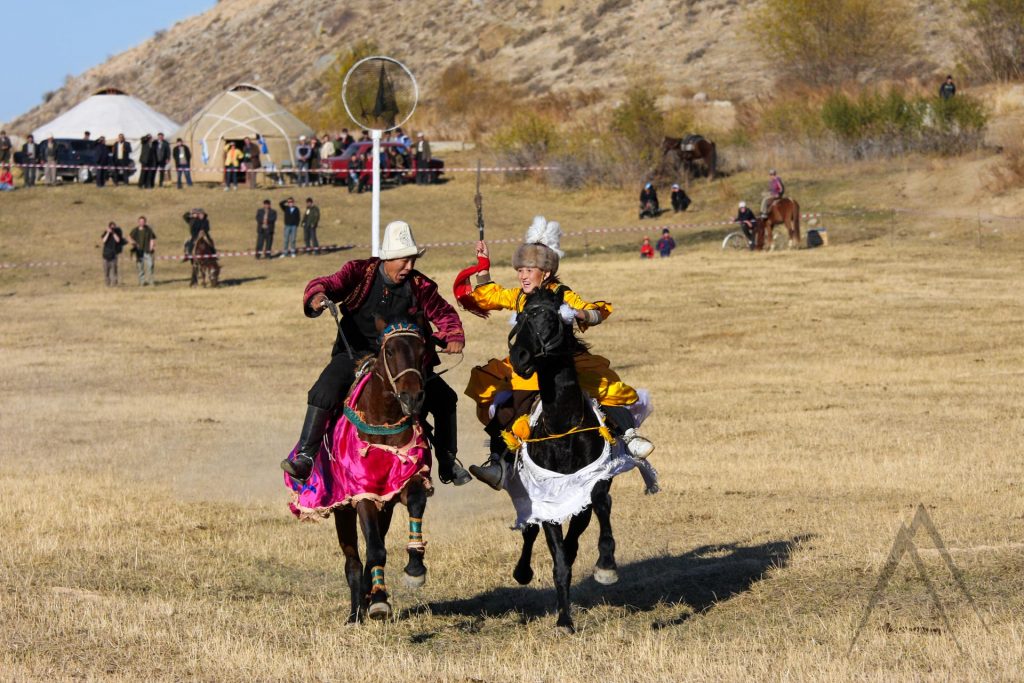
Most Kyrgyz nomadic sports are practiced during the winter time as the villages mostly live from agriculture and vice versa with the animals being herded in the summer time and crops grown. Best places to see Kyrgyz nomad games are in Issyk Kul, Suusamur, Alai, Chon Kemin and other rural areas. Games might be organized fairly randomly and one can stumble on one just by arriving at the right place at the right time. With Kok Boru there is also a national league starting. The World Nomadic games have been organized in Cholpon Ata several times but it is not yet known when they will be again organized there.
Horses have always played an essential role in the lives of the Central Asian nomads and they were one of the first people in the world to learn the skill of horseback riding. The nomads practically lived on their saddles while roaming the endless steppes and jailoos and their children learned how to ride horses before they could barely walk. The horse was a loyal companion that enabled the nomads to travel far and fast. Even today, young boys (and girls) often practice their riding skills on donkeys until they’re big enough to ride a horse and it is not rare to see a few year old boy riding a horse by himself.
That being said, horsemanship is still a much-revered skill in Kyrgyzstan. The boys of the small towns and villages still learn to master the riding skills as they grow up. That’s why national games and sports in which the people demonstrate their equestrian skills are an integral part of the Kyrgyz culture.
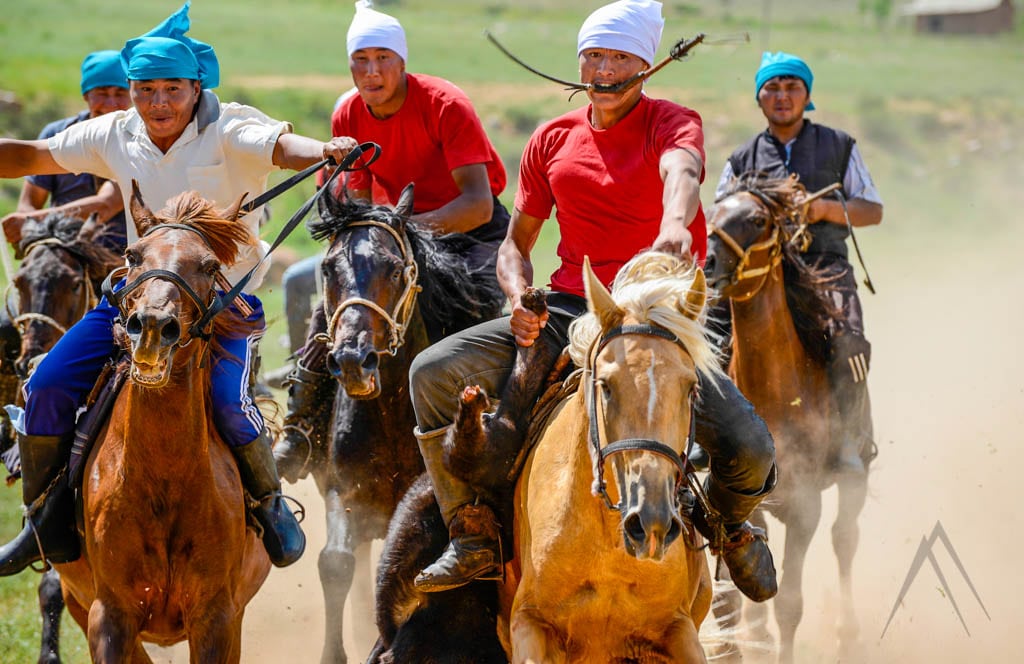

Relax at the beaches of Issyk Kul and explore the beautiful mountain valleys around it
Issyk Kul is one of the most surreal places that one will ever find while traveling Central Asia. Imagine a great sandy beach in +25C weather, next to a crystal clear enormous water body (almost like a sea) and in the distance you see the snow capped Tien Shan mountains reaching 4-5 km and once in a while you can still get a glimpse of some old soviet era monument. All this is surrounded by amazing nature in the tens of beautiful mountain valleys and gorges and topped with some ancient silk road ruins and artifacts, not forgetting the several geological formations and hot springs.
Issyk Kul is one of the largest and deepest lakes in the world and is the second largest alpine lake on Earth. Due to its massive size and slight salinity, it never freezes in the winter which suits its name well as the word Issyk Kul means “hot lake” in Kyrgyz language.
There are plenty of things to do around Issyk Kul and one can easily spend a week just exploring this large area. Whilst here, you can join a sunset cruise, go on a road trip to the mountain valleys or trek in them, enjoy the several Issyk Kul hot springs or just lay on one of the beaches if you like. Some of Kyrgyzstan’s top destinations are also found around the lake, like Jeti Oguz, Barskoon Gorge, Fairytale canyon and Chopon Ata. No matter what you are looking for, Issyk Kul is a place to visit while traveling in Kyrgyzstan.
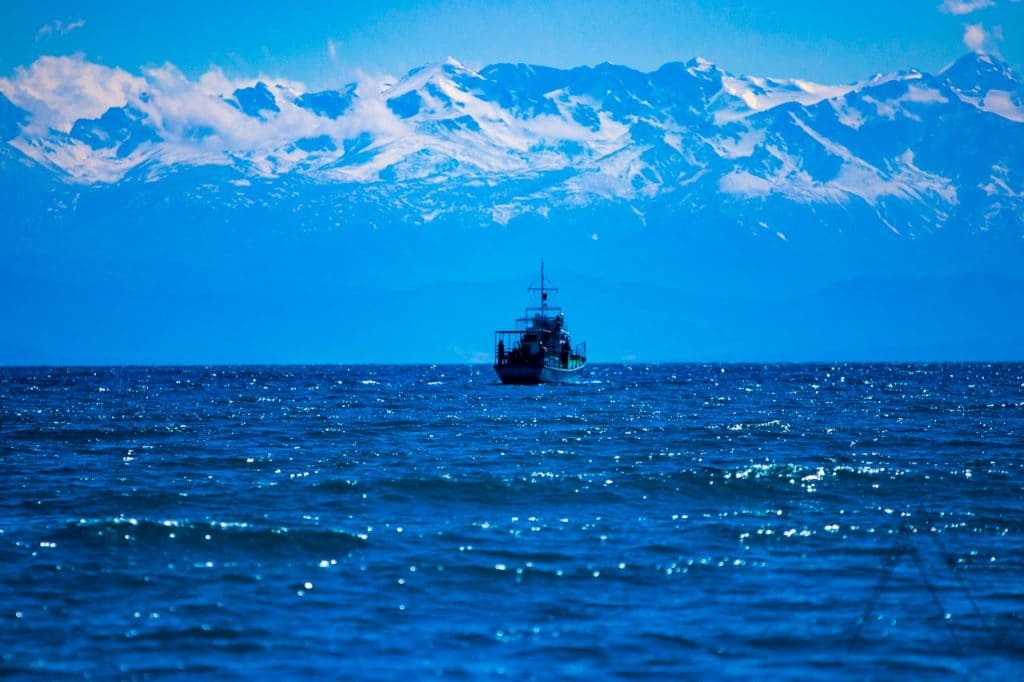
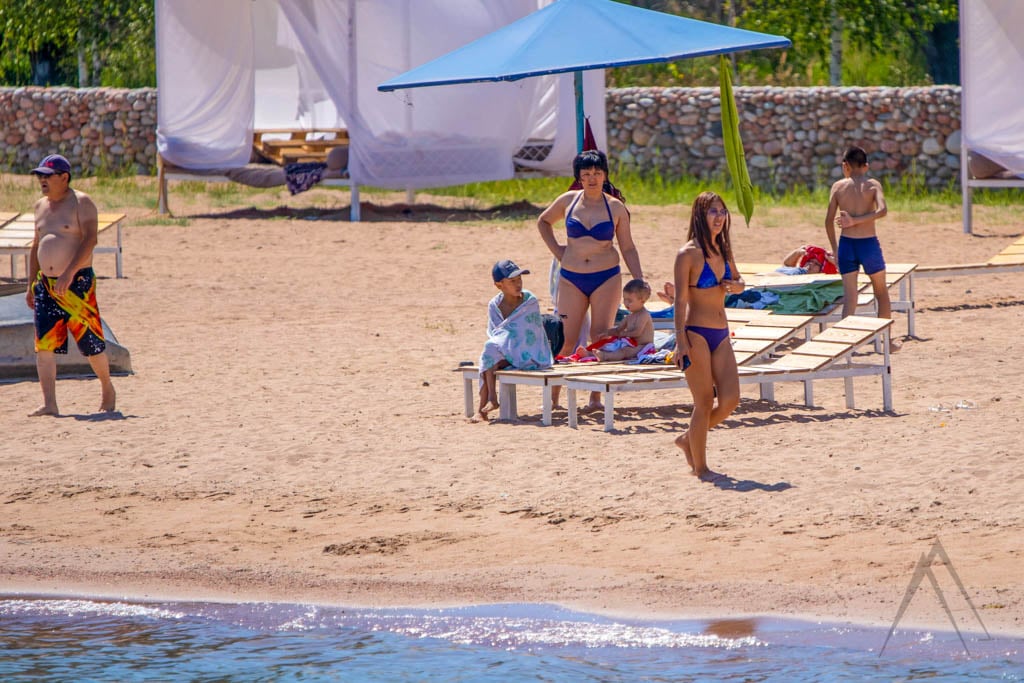
See Eagle hunting or hold the heavy eagle in your hand
Eagle hunting is a very old and very respected tradition in Kyrgyz nomadic culture. As the name implies, eagle hunting is the act of raising local golden eagles from egg or young bird to track and hunt prey either for sport or sustenance like food, pelts and so on. It is the same tradition that you see also in Kazakhstan and Mongolia. The animals hunted are usually rabbits, foxes and other small mammals.
It goes without saying that hunting with eagles isn’t really necessary in the modern era. In fact, most of the native Kyrgyz population has abandoned the tradition altogether. That being said, there is still a group of people that are doing their best to keep the nomadic spirit alive.
The Salbuurun Federation, based in the town of Bokonbayevo on the south shore of Issyk Kul, are the preservers of eagle hunting traditions. This small group of locals offer eagle hunting shows to those interested in learning. They are both educational and exciting because, let’s be honest, what’s cooler than watching a master controlling an animal with a wingspan as long as a full grown man. There are also many many places in Issyk Kul especially, where you have the possibility to hold the eagle in your hand for a small fee.
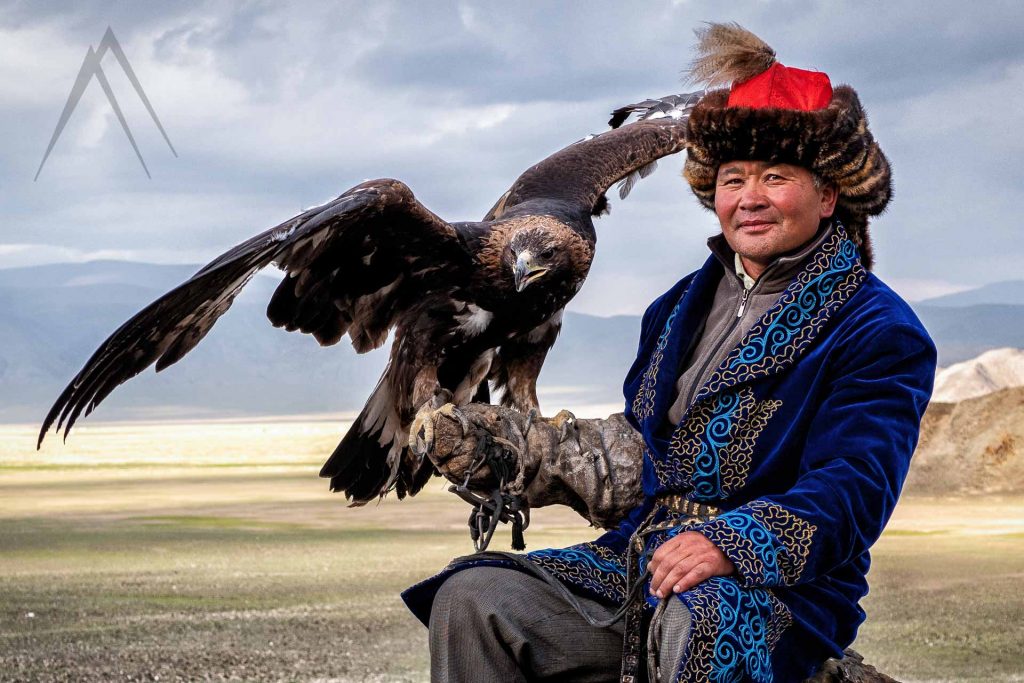

Explore the amazing waterfalls of Kyrgyzstan
Kyrgyzstan has tens if not hundreds of amazing waterfalls to be explored. It seems that most of the valleys in the vast Tien Shan mountain ranges are hiding at least one or two of them. The thing is that one often needs to make a little effort to reach them, at least the most amazing ones. The closest ones from Bishkek are just an hour or two drive south from Bishkek to the nearby valleys. Another easy one but at the same time an amazing waterfall are the four Barskoon waterfalls at the south shore of Issyk Kul and not far from is the Jeti Oguz valley with another very different waterfall.
If you are more into hiking and wish to see something spectacular you should hike about 10 kilometers to see the largest waterfall in Central Asia called the Shar waterfall. Shaar waterfall is located in the Naryn region of Kyrgyzstan and boasts with a dazzling height of more than 300 meters of waterfalls including all the cascades and the longest one surpassing 200 meters.
In the southern areas of Kyrgyzstan the mountains are sometimes carstic which means that the water has created a lot of caves and carved its way through the rock over time. A good example of this is the Abshir Ata where the water shoots out straight from a cave on a vertical cliff located in the namesake gorge. There are also two very nice waterfalls inside the Arslanbob nut forest that we will tell more about a bit later.
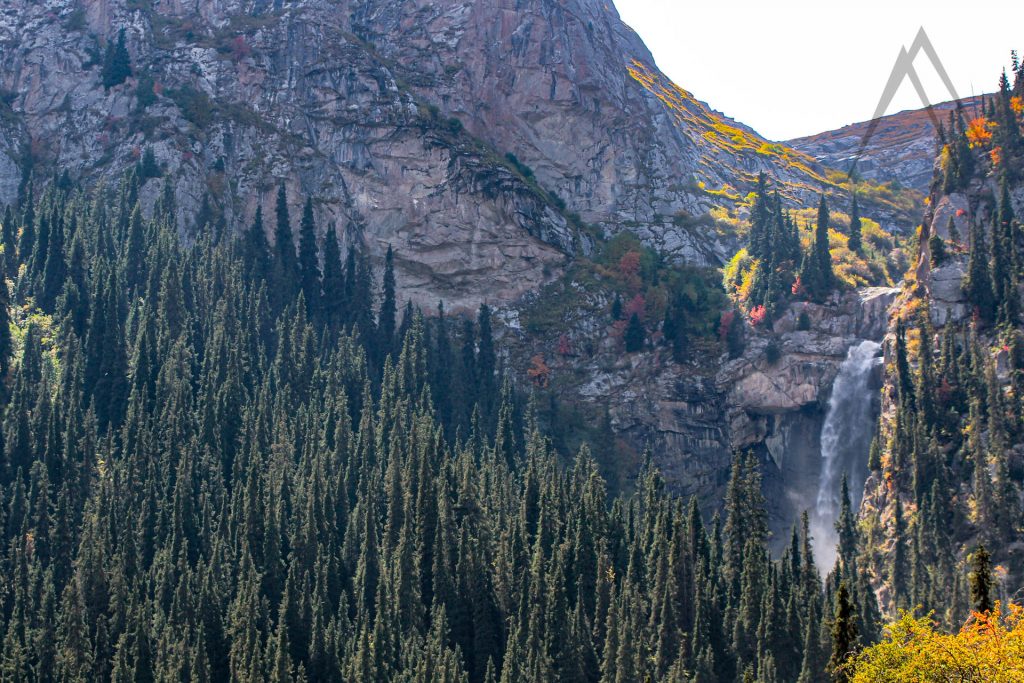
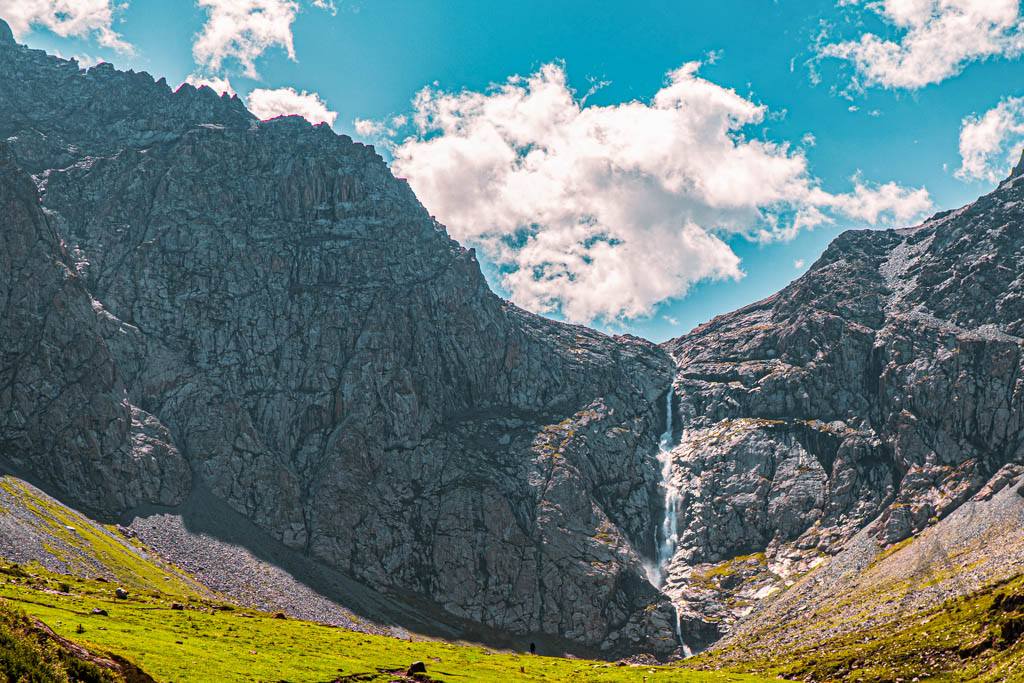
Bathe in the Kyrgyzstan's many natural hot springs
Kyrgyzstan has plenty of hot springs scattered around the country from north to south. Most of them are located in Issyk Kul area where one can find a lot of options on both the south and northern shores. In the north shore the hot springs are centered around Cholpon Ata, to both west and east from it. In the south and southeast side, the hot springs are focused nearby Karakol, in the Ak Suu, Altyn Arashan at the height of 3 km, Jeti Oguz and Juuku valleys with more of them towards west along the shoreline of the lake. Altyn Arashan hot springs are often combined with a hike to Ala Kol lake which is located high up in the mountains between the Altyn Arashan and Karakol valleys.
There are also few to try just nearby the Bishkek like in the Issyk Ata valley which offers two outside pools together with a Soviet era sanatorium which is in demand of the locals mostly though. The outdoor pools here are extremely relaxing and atmospheric in the colder winter times when snow is falling and the water is steaming around you. Another Soviet style sanatorium near Bishkek with thermal waters can be found in Alamedin valley. There you can also try tasting mineral waters from different springs.
In the Southern Kyrgyzstan, hot springs can be found in Jalalabad sanatorium but they are in desperate need of renovation.
Most of the Kyrgyz hot springs are located in the mountains meaning that you can admire mountain slopes and peaks while soaking in the mineral rich waters. It is common that there are several pools of different water temperatures and you can change from too hot to colder and to extremely cold as well if the heat becomes unbearable. When moving straight from a hot pool to a very cold one, it really wakes you up! You can also check the hot springs of other Central Asian countries.
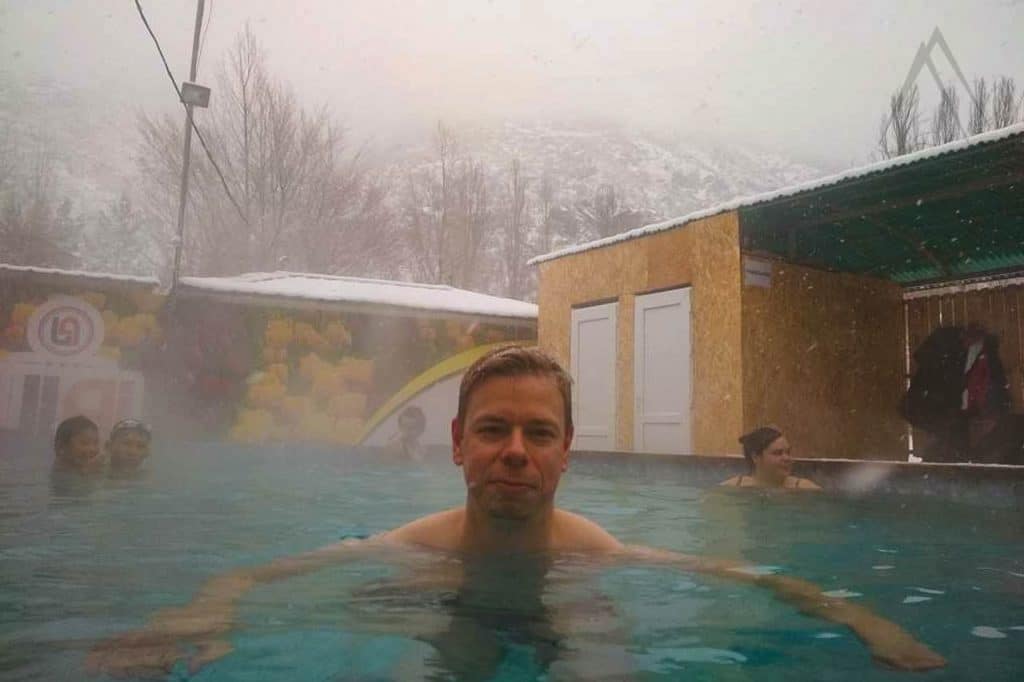

How to experience Kyrgyz culture & history
Taste the Kyrgyz foods
Kyrgyz food culture is a very carnivorous one and can therefore be an obstacle for vegetarians especially in the rural areas. A common joke suggests that only wolves eat more meat than Kyrgyz and meat really is the starter, the main dish and the desert for almost every meal in this country. In Bishkek one can easily find some vegetarian food together with several international cuisine restaurants. In general Kyrgyz food is very tasty and does not have much spices in it in addition to salt and pepper.
Traditional Kyrgyz food has meat in a variety of ways. grilled, minced, boiled, charred, dried and the list goes on. Like most of the countries, Kyrgyzstan also has their own things that might not be very appealing to foreigners but remember that the head of the lamb is usually served for the most honored guest which the foreigners often are. It is still acceptable to politely decline and the locals will understand it well. As Kyrgyzstan is near China they have received a lot of influence to their food culture from east. Lagman is a noodle based dish with meat and vegetables actually from Uighur culture but it is very common in Kyrgyzstan. There are many different versions of lagman from several different soupy ones to fried ones called boso lagman.
Shashlik, which is essentially shish kebab, was introduced to the area by the Russians and is much-loved in the country. Manti are the Kyrgyz version of dumplings but they are bigger than in most other food cultures. Manti usually comes with meat, fat and onion inside but during the harvest season they might also include pumpkin which is very good. Shorpo is basically boiled beef or lamb in broth usually with onion, carrot and other vegetables. Samsy are also usually cooked in a tandir oven and they are basically a bread cover with meat, fat and onion inside them and they are delicious!
There are still some solid non-meat dishes in Kyrgyzstan. Salads are quite popular, especially those involving tomato, cucumber, and carrot. Bread baked in tandir oven is all around and costs about 20 soms (0,2 €) and eggs are also found everywhere. If you are offered meat but don’t want to have it, just learn how to say “no meat for me” in Russian “ mne net myasa” and you’ll be fine.
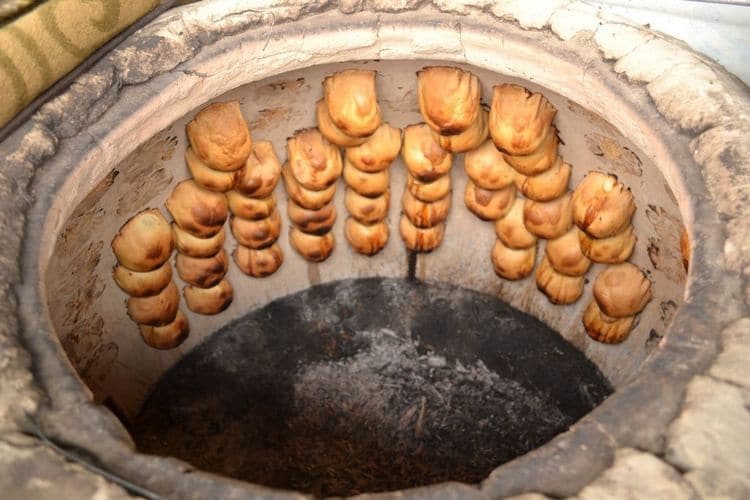
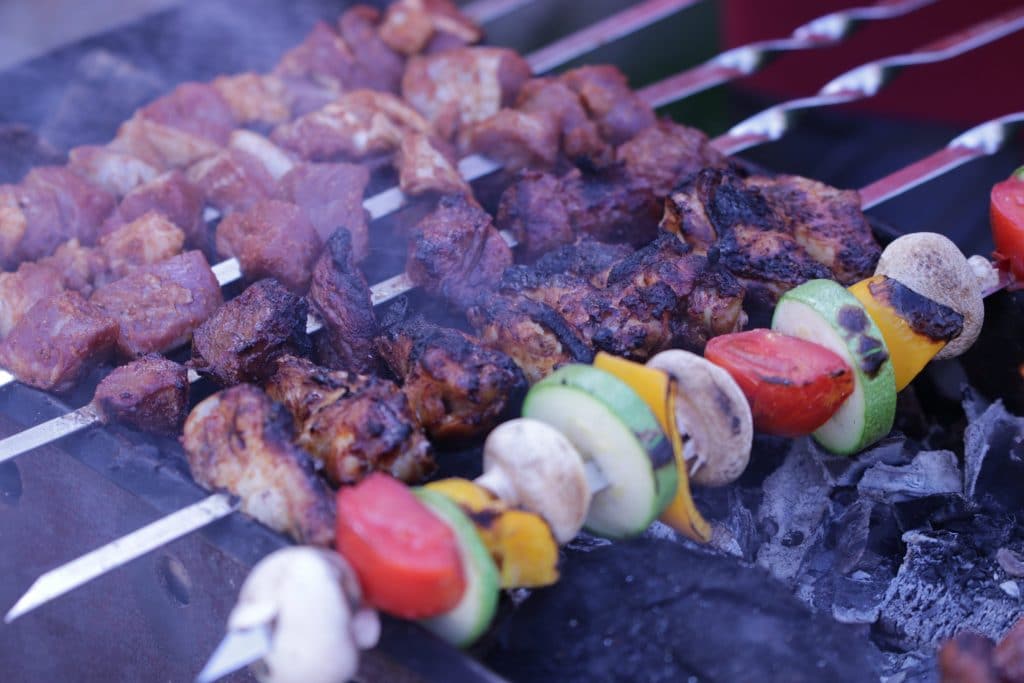
Visit a local Kyrgyz bazar
Kyrgz people love a good market (bazar). Besides being their one-stop-shop for everything from groceries to household products, the local markets also double as social gatherings. More than anything, locals often come to these markets just to drink tea and eat affordable food and to discuss the daily matters with relatives and friends. From the perspective of an outsider the bazars might seem quite hectic and chaotic though.
There are several types of markets in Kyrgyzstan. The traditional bazaar with fresh products from vegetables to meat is the most common type you’ll find and probably is also the most exciting. Bigger cities like Bishkek, Osh, Jalalabad and Karakol have several of them and usually they focus on some certain type of products so it might be worth to explore several of them. Osh bazar is the main bazar of Bishkek and is an exemption in the rule as it has everything one could possible imagine maybe excluding the cars and other large items that can be found in the Dordoi bazar of Bishkek.
One of the more unique things to do in Kyrgyzstan is attending the weekly animal market in Karakol that takes place every Sunday morning. Here the locals buy, sell and trade domesticated animals and is already finished by mid day or even earlier.
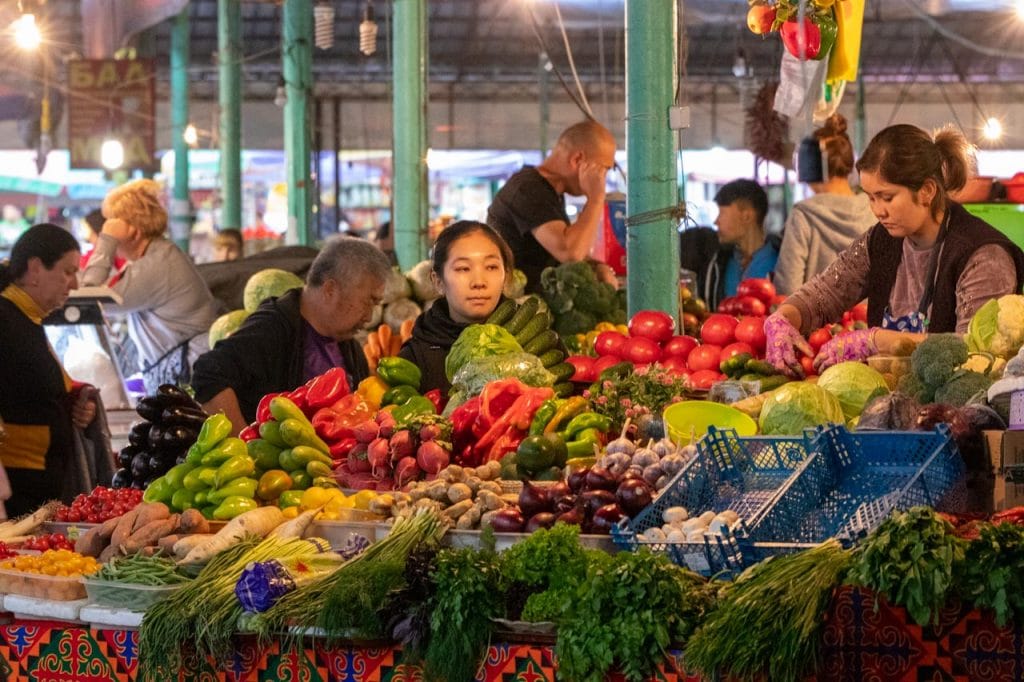
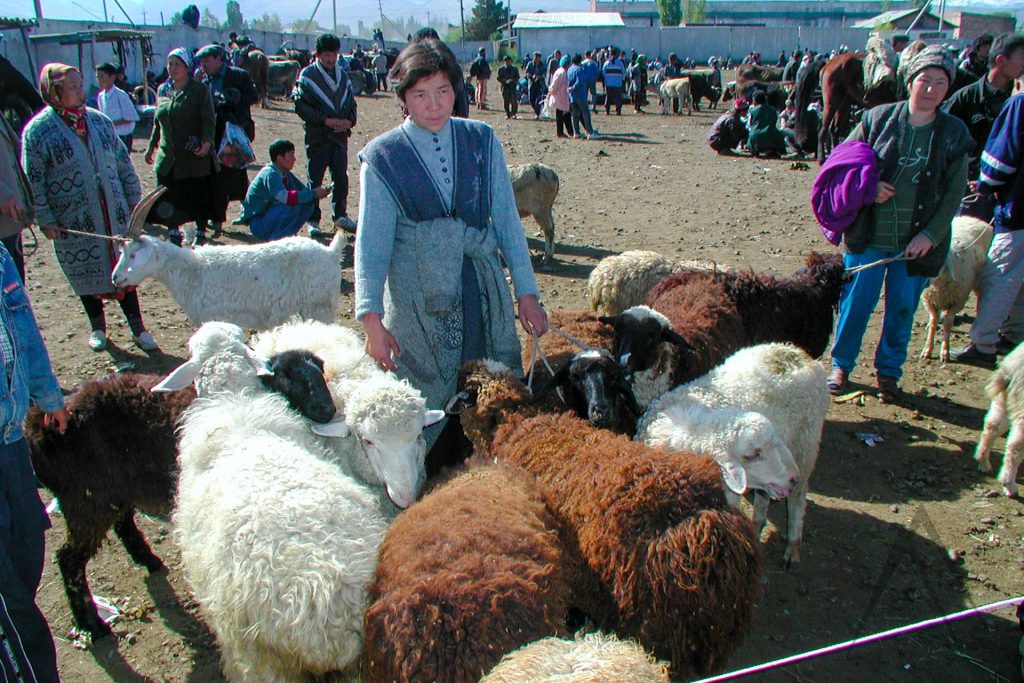
Search for old nomadic petroglyphs and balbal burial stones
Kyrgyzstan has an uncountable number of locations where the peoples from the past have left their markings on the stones in the form of petroglyphs. These ancient drawings very often describe animals, sun, hunting or other important aspects of the life during the time of their making. The most easily accessible location to admire Petroglyphs is in Cholpon Ata by the northern beach of Issyk Kul, just north from the city where they have been collected together with other ancient artifacts including some balbals. One of the finest petroglyphs sites can be found in the Saimaluu Tash, in a hard to reach location on a mountain range between Kazarman and Jalalabad. In addition they can be found in many many locations around Kyrgyzstan, mostly inside some of the valleys that have been inhabited in the ancient times but also in Song Kul.
Balbals are ancient burial stones that portray people usually with weapons and were made by nomadic Turkic tribes living in the region from the 6th century onwards. There are couple of places in Kyrgyzstan where a lot of balbals have been collected. You can find many of them next to the Burana tower and also big collection inside the national history museum in Bishkek. These gravestones had originally also small stones next to them representing the number of the enemies slain by the dead. The bal-bals are oddly proportioned with heads and short torsos, characterized by detailed carvings of faces and hands and have often quite remarkable face expressions.
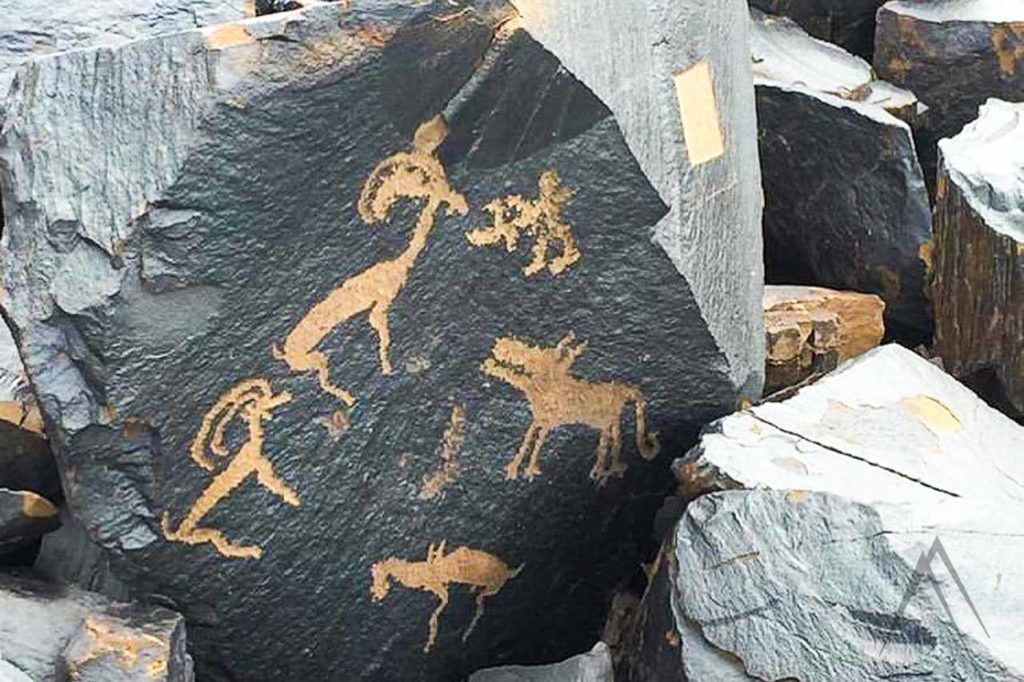
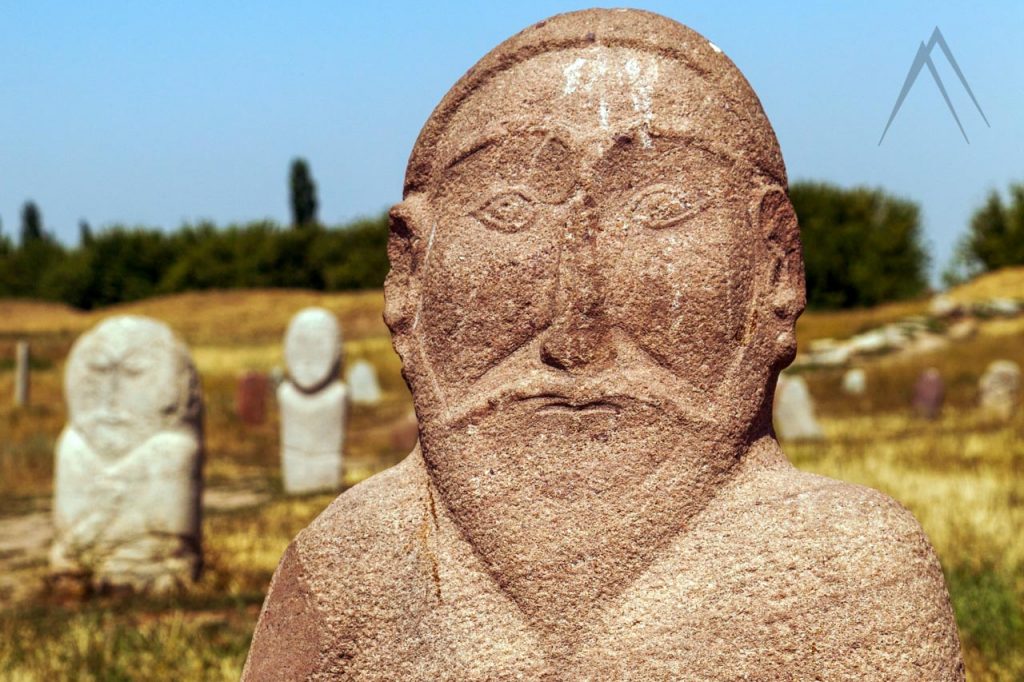
Follow the Silk Road in Kyrgyzstan
The northern and middle routes of Silk Road passed through Kyrgyzstan. The middle one had two routes inside Kyrgyzstan with the first the first one passing from Chatyr Kul lake and the Torugart pass towards Issyk Kul and the Chui valley where also the northern route joined from Almaty direction to pass along the several medieval cities of Chui valley. The middle road passed from Kashgar to Osh through the Arpa valley and continued westwards along the Fergana valley. It is also possible that during some periods the northern route followed the shoreline of Issyk Kul and that Alay Valley was also used to travel towards Penjikent to have a more straight road from Kashgar.
Nevertheless, Silk Road has been influencing Kyrgyzstan and the vice versa along the course of history. Unfortunately a lot of the Silk road heritage has been lost due to the invasion of Mongols which has been the fate of most of Central Asian cities and monuments. Continue reading on the next chapter to learn about the Kyrgyzstan’s fairly unknown medieval and Silk Road city ruins!

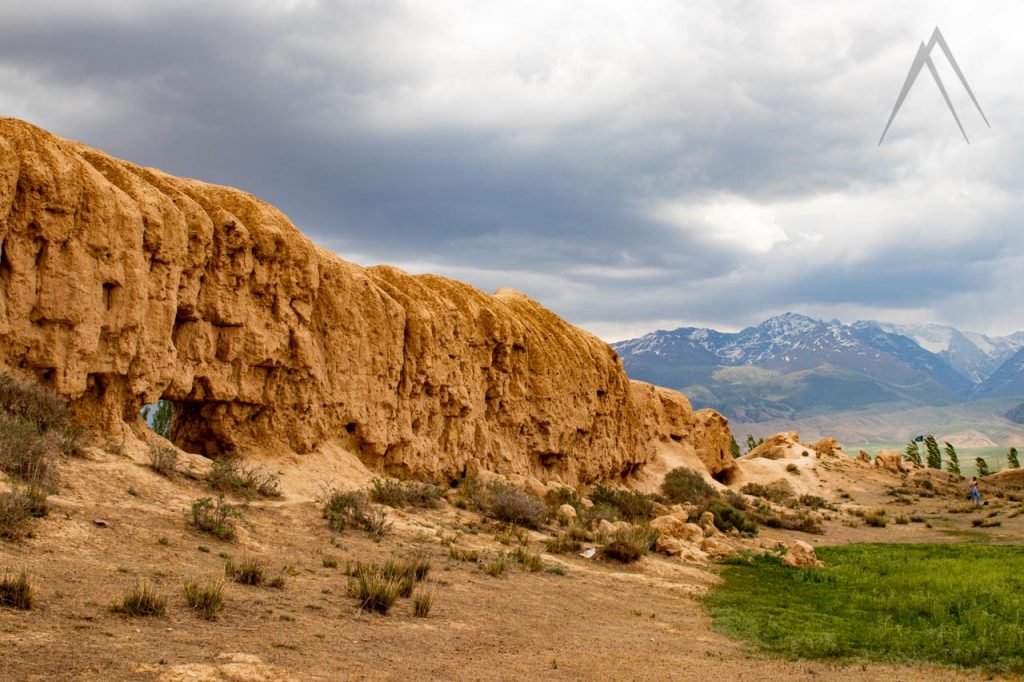
Roam freely in the Kyrgyzstan's medieval walled city ruins
Have you ever wondered why there are no medieval or ancient Silk Road cities in Kyrgyzstan when Uzbekistan has hundreds of them? Wonder no more as Kyrgyzstan has a lot of them, they are just very badly known! Just nearby Bishkek, in Chui Valley there are three major ruin sites to explore and several smaller and they are mostly free to be roamed as they are not much excavated or established and one can easily find pieces of pottery laying around. Delve deeper into Kyrgyzstan and you will find tens of them. It seems that the more rainy and cold climate of Kyrgyzstan compared to the more desert climate of Uzbekistan and Turkmenistan, has not preserved these sights as well as in the neighboring countries.

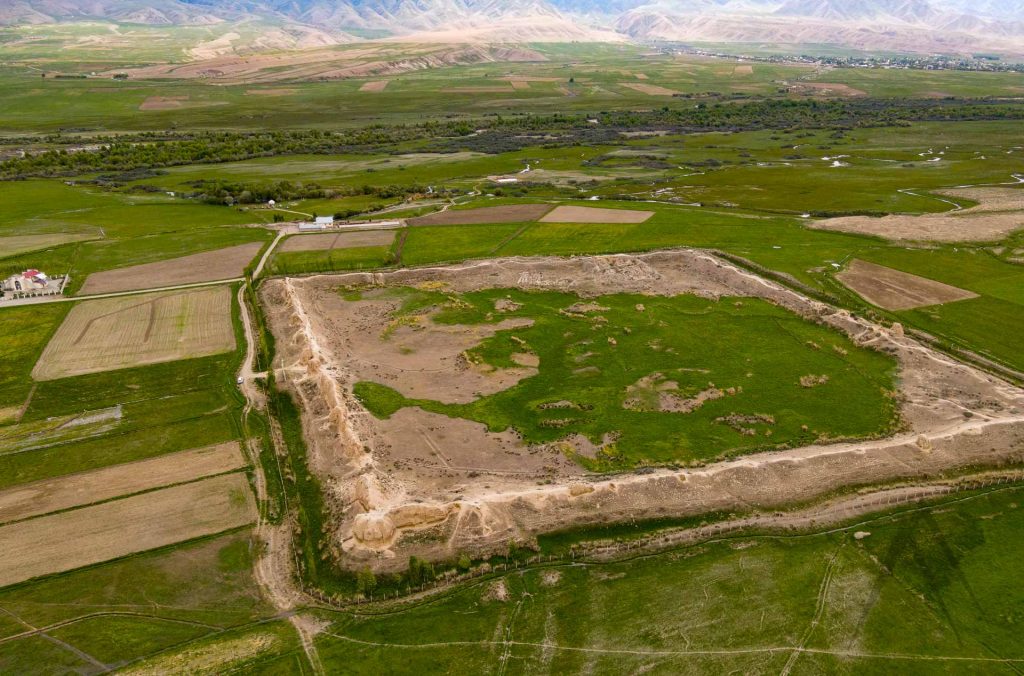
The most famous Silk Road fortresses or medieval sights in Kyrgyzstan are the Burana tower, Tash rabat caravanserai and the Koshoi Korgon walled city ruins. Burana Tower is actually a minaret of the Balasagun city that was once a capital of a large region in Central Asia. Koshoi Korgon is not far from Naryn and was originally a fortress city built by the Turks that held the area in the history. A far less known fact is that there are also many fortress ruins in Issyk Kul area and in other parts of Kyrgyzstan as well all the way from Batken to Arpa valley. We will write a comprehensive guide about these a little bit later.


Different and unusual things to do in Kyrgyzstan
Party in the Kolfest at the south beach of Issyk Kul
Kolfest is the first international music and contemporary art festival in Central Asia organized since 2019. It is held in the village of Ton just by the southern beach of Issyk Kul, usually in the latter part of July. Tens of artists and musicians gather to perform, organize interactive games, exhibitions and workshops. The amount of guests has still been under 1000 each year but it is expected to grow yearly.
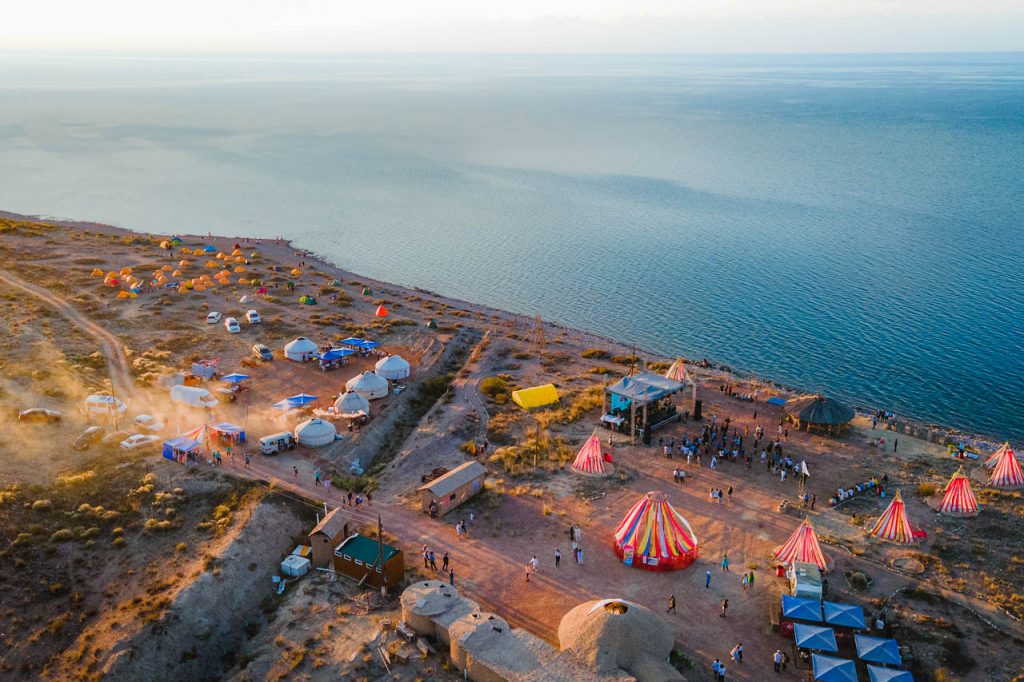
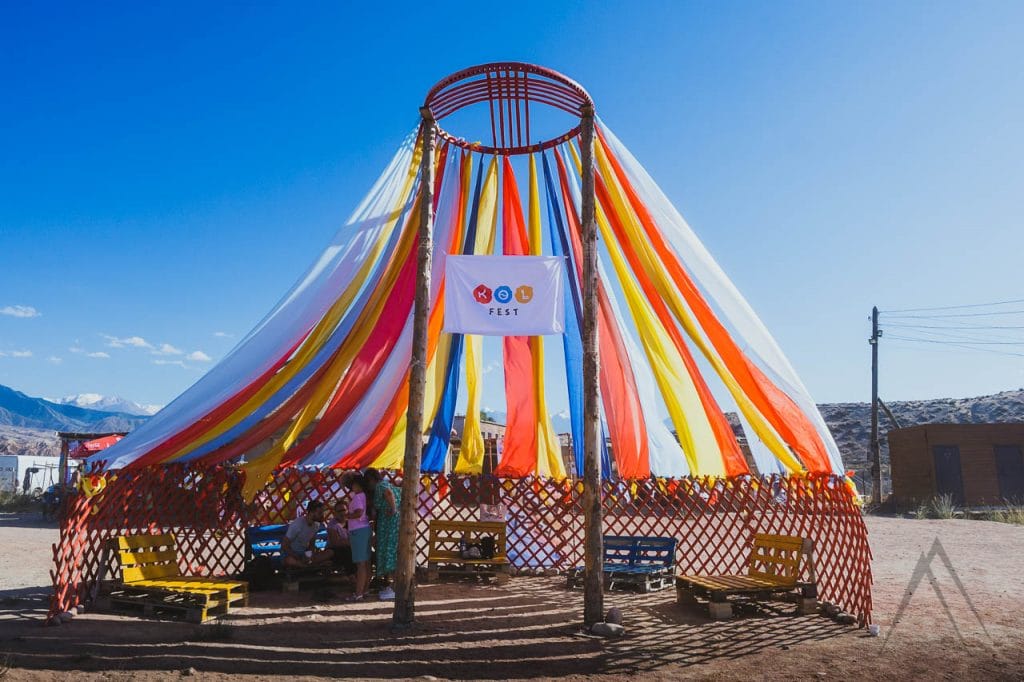
Experiencing this unique festival and the atmosphere during the festival are something that the participants will never forget. The organizers have targeted foreigners as an audience from the beginning of the festival. For the most authentic experience, tent accommodation is recommended, but there are also options in the nearby villages.


Dark Tourism in Kyrgyzstan
The so called dark tourism is a form of tourism where people want to go visit places that do not fall to the traditional category of beautiful or pleasant things. Good examples are abandoned cities and industrial complexes. Kyrgyzstan also has its own dark heritage and most of it is from the Soviet era. There are some locations that are indeed very dark but we do not advice you to go to any place near them as they are related to uranium mining and processing that took place in Kyrgyzstan.
Less dangerous but very interesting places to see in Kyrgyzstan in this sphere are the abandoned mining city of Enilchek high in the Tien Shan mountains and the Tashkomyr town which used to be a center of coal mining in the southern part of Kyrgyzstan. Issyk Kul area also has some old remains from the coal transportation in form of harbors that are no longer used.

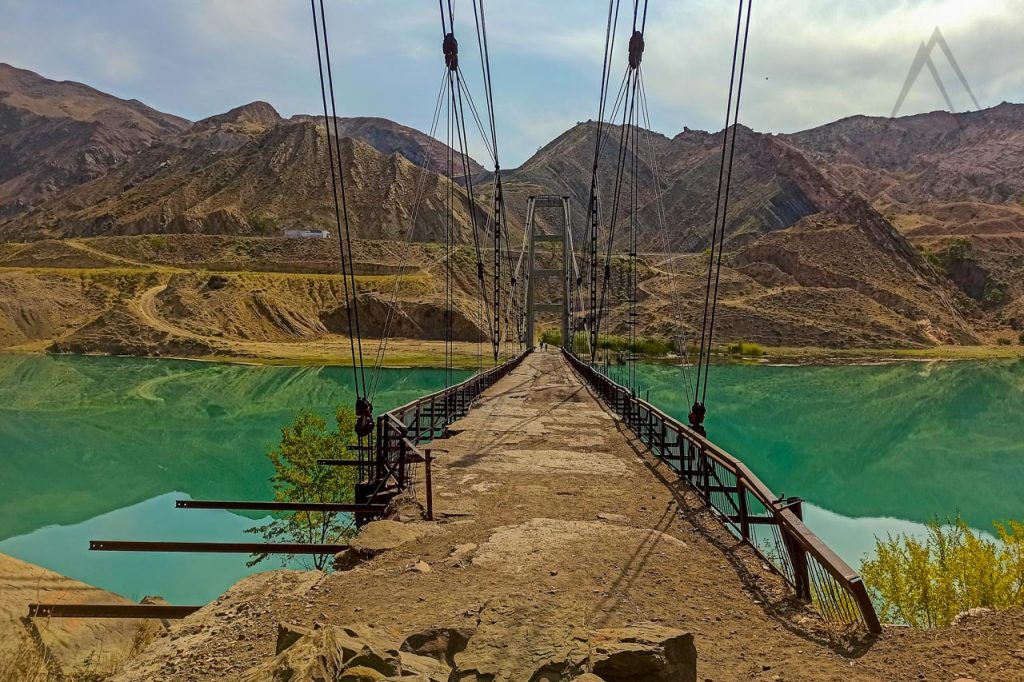
Hunt for the signs of Kyrgyz Soviet heritage
Kyrgyz people have been very gentle towards all the signs of Soviet union and have not been in a hurry in removing them. You can find some sickle and hammers still even in Bishkek and the Lenin statue of the Kyrgyz Soviet republic capital has been just transferred in a park behind the national history museum. In the “Southern capital of Kyrgyzstan” Osh, the second largest Lenin of Central Asia (Largest is in Khujand, Tajikistan) is still standing in the primary spot of the city along the main street and the government buildings.
If you venture further to the villages in the rural areas, it is not uncommon to spot the silver Lenin statue next to the municipal buildings. Another significant heritage and a form of art are the Soviet mosaics that can be mostly found in Bishkek and Osh. Another huge sign of Soviet heritage is the head of Lenin by the Kirov reservoir in Talas region of Western Kyrgyzstan. Interested in locomotives? Try climbing on the walking bridge over the Bishkek train station and see the Soviet trains and wagons in action.
If you want to take something Soviet home, it is best to visit the Orto Say weekend bazar, where people take over the street and sell their old belongings. A big portion of the stuff sold are from the Soviet period including old cameras, household stuff, Soviet medals and pins and other interesting things.


Drink Kymyz, try Kurut and even learn how to prepare them
As a nomad culture Kyrgyz people have developed a lot of different products from the milk of the animals. In the old times the ability to preserve the food has been an issue and therefore adding a lot of salt or other measures must have been taken in order to make sure that there is something to eat all around the year.
Trying these milk products is one of those cultural oddities that one really tries to appreciate, but most likely struggles mightily trying to. Kymyz (Kumis) is basically fermented mare’s milk that goes through a certain process before drinking it. During the early summer period, when the calves are born, mares are milked and their milk is then fermented for an extended period of time, traditionally in a container made from the stomach of a sheep. In the process, sugars are fermented into alcohol and the milk becomes preserved. Therefore kymyz is essentially a warm, bubbly, salty, alcoholic milk that comes from a female horse’s tit.
To speak the truth, kymyz is one the strangest, sourest, most difficult things that you will most likely ever drink. The experience is seriously hard to describe but its still worth taking a few sips to see for yourself.
Despite its acquired taste, kymyz is a delicacy in Kyrgyzstan. Nomads trade it in local markets like it was the white truffles in France. Some locals even go on vacations specifically to drink kymyz as they believe that by drinking it their bodies will be purified of toxins which will literally happen (in the toilet) if you drink a lot of kymyz!
Kurut is an easier one to stomach. It is basically dried salty yogurt that has a strong taste of farm animals. It is made by letting the yogurt to dry in the sun after creating small balls out of it. Some of the people in Western world have even liked it and it goes especially well with beer as a salty snack. Local people will be glad to let you take part in the process of preparing kurut.
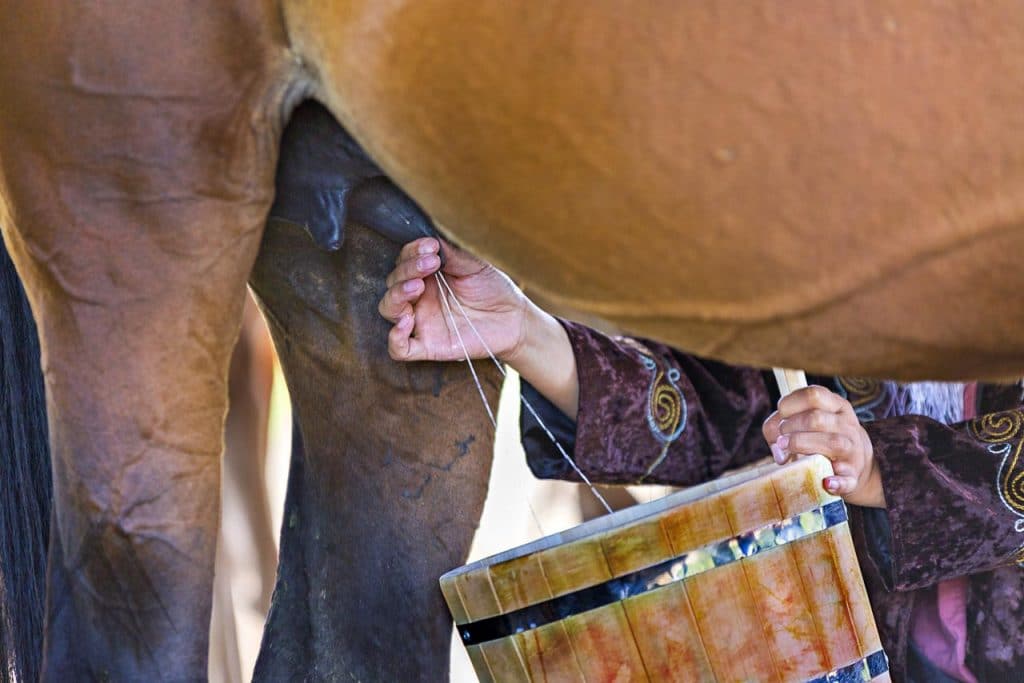
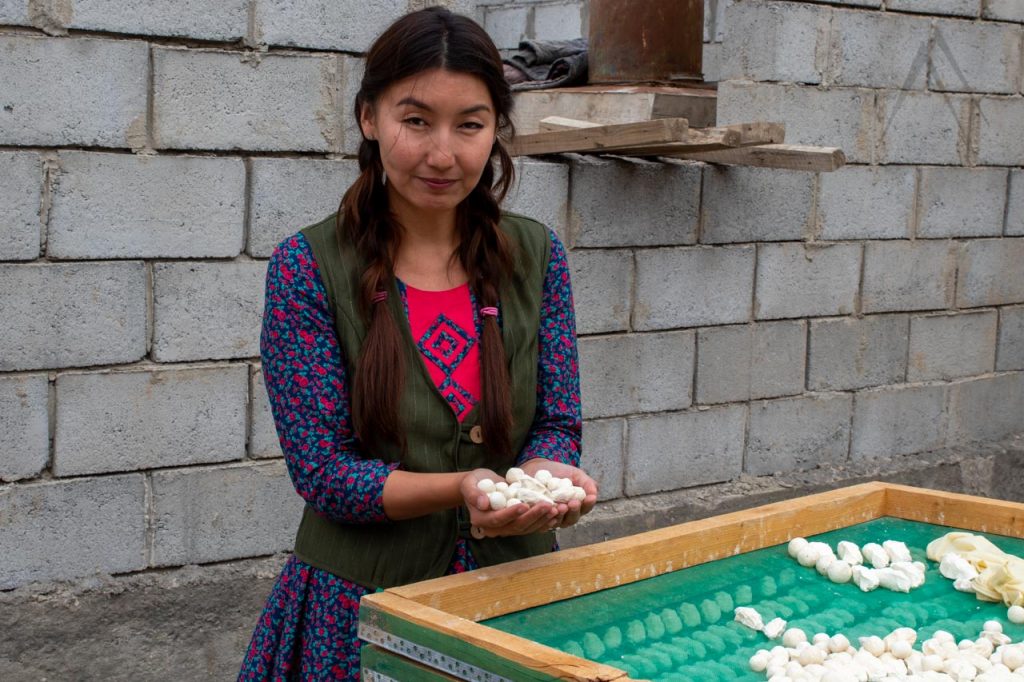
Relax in Kyrgyz banya (sauna)
Kyrgyzstan has a very lively banya (sauna in Russian) culture all around the country. People do not mostly have their own saunas in the apartments or houses, but instead spend time in public saunas and spas. In many places you can also use the bunch of branches to flog your body causing and amazing feeling and smell. In several better places you can enjoy several types of saunas including Russian, Finnish, Turkish and more. You can also buy different kind of massages and other treatments. It is also very common to spend most of a Sunday or a public holiday in one of the many many options. While in spa or banya, people eat and sometimes also drink alcohol.
It is also very common to find a pool or even several of them along the saunas where you can cool off between the steamy sessions. You can find banyas everywhere in Kyrgyzstan but information is not always available online so it is best to ask from your local host for the recommendations and locations. Men and women always bathe separately in Kyrgyz banyas.
Travel by Kyrgyz public transportation
If you want to experience the local way of traveling you should really try marshrutkas or shared taxis. Locals in Kyrgyzstan mostly travel in a social way, commonly together with unknown people. A shared taxi is basically sharing a taxi with 4 to 6 other people, depending on the size of the car. A mashrutka is a minibus that looks like a van. Some of them are quite comfortable and have air conditioning, others are decades-old and aren’t the most fun to travel in when it’s super hot during the summer.
Ever tried a Soviet cable car? You have the possibility in Bishkek and surprisingly also in Naryn along the only major street of the town that goes on for more than 20 kilometers. There is also the option to travel to Issyk Kul (Balykchi at the west part of the lake) by train from Bishkek. It is a great way to see the villages on the way along the stops and to observe the life outside Bishkek. It is also very inexpensive, but takes more time than by the road so only consider this option if you have the time.
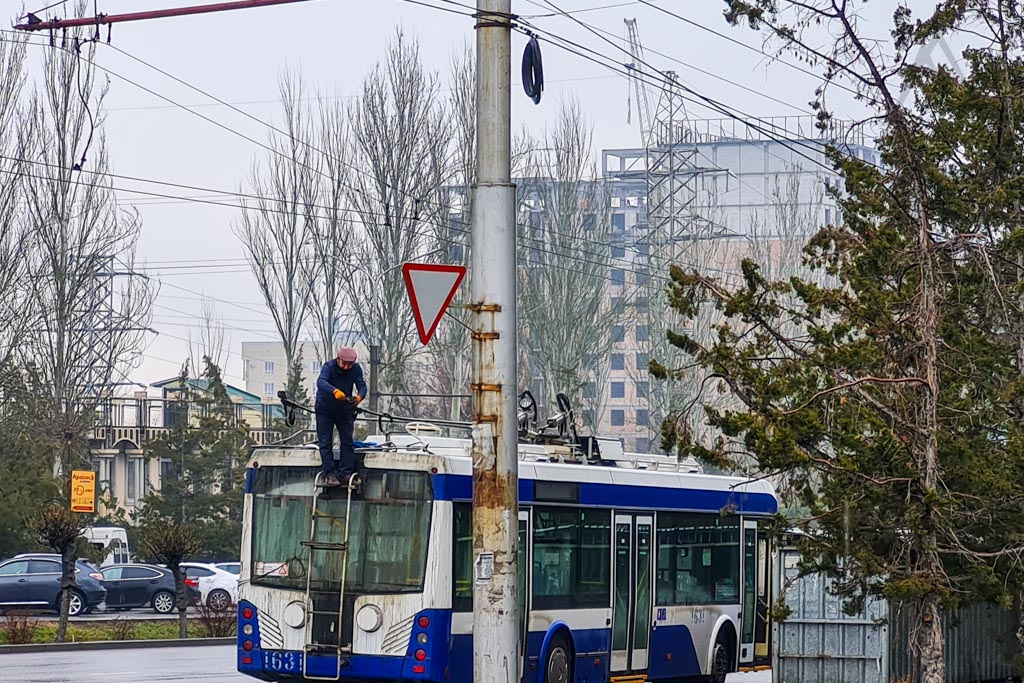

Explore the caves of Kyrgyzstan
As Kyrgyzstan is a very mountainous country, and actually more than 90 % of its area is mountains, it is not a surprise that there are many many caves in the country. Most of the caves are found in the Southern regions as the type or rock is better suited for the formation of caves there but there are also many caves in other regions too. There are also several spots where people have made caves during the older times while mining metals or minerals and some of the mines date very far back to the history.
This all being said, the caves of Kyrgyzstan are not really established for tourism yet and very many of them are extremely hard to reach. There are projects ongoing that aim in having some locations for tourists but before that you should only visit the caves with the help of local experts not only to protect your own health but also to protect the caves.
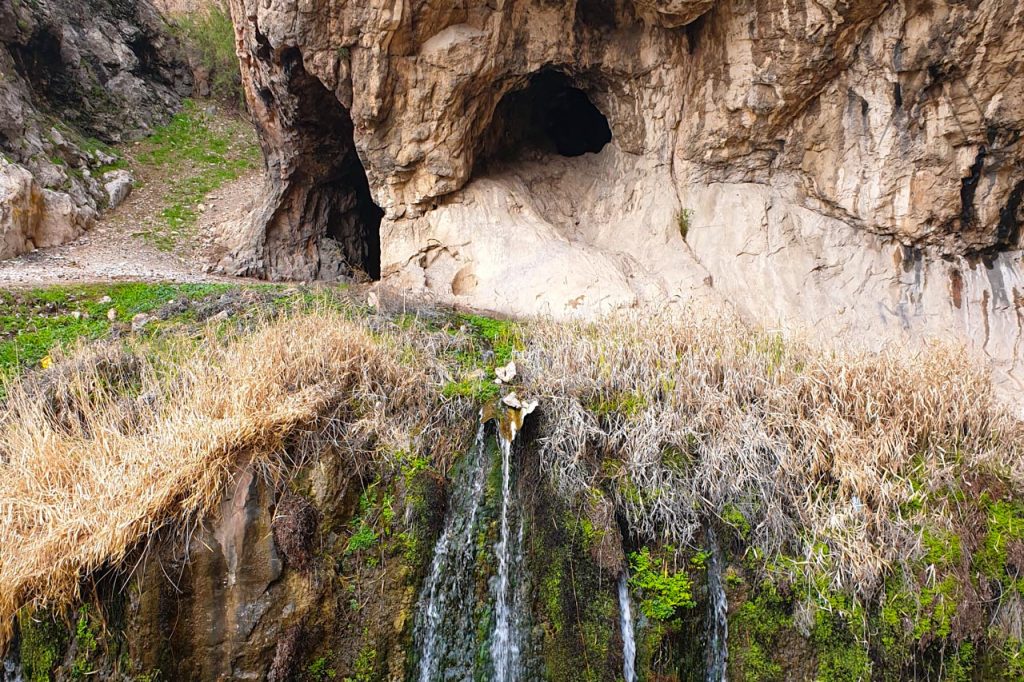
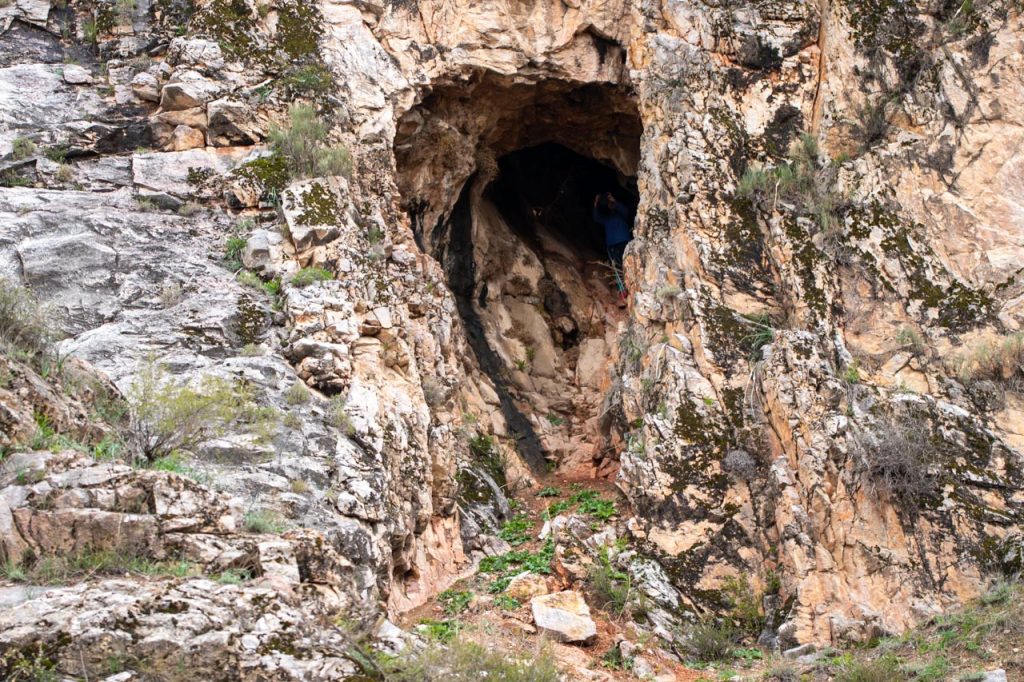
What to do in Kyrgyz Cities & Villages
Go on a brewery tour in Bishkek
One might think it is surprising to find a flourishing beer scene at the capital of a muslim country, but in this sense Bishkek is very secular. There are several restaurants and pubs in Bishkek that have their own beers and even own beer production. Most of Kyrgyz beers are light lagers but some places have also ventured to the world of darker beers and ever sours. The most famous beer in Kyrgyzstan is the Arpa, which translates as barley, and it is an easy going light beer that will surely cool you down on a hot summer day.
Steinbrau is the place that started the small scale brewery scene and is still producing its German type beers and serving them in the traditional wooden style pub. They also organize a nice Oktoberfest party yearly. Other beer places worth mentioning in Bishkek are Save the Ales, which is by the way owned and managed by women and another one is the Blonder pub little bit away from the city center. Blonder Pub is a Bavarian type place with good sausages as well.
When giving some more thought it is not that strange to find good beers in Kyrgyzstan as there are abundant amounts of clean water and hops and barley grow well in the Kyrgyzstan’s climate.


Experience different Kyrgyz culture in Osh
Osh is known as the “Southern capital of Kyrgyzstan”. It is the second largest city of the country and is very different from Bishkek both culturally and age vise. Osh has been around for at least 2000 years and even more while Bishkek was only born some hundreds of years ago and really started to grow only after the Russian occupation. Osh has been one of the major Silk Road stops at the eastern side of the Fergana valley together with the ancient cities like Aksikent and Mingtepa that now mostly reside in the Uzbek side of the border.
The culture in Osh is a lot more Uzbek than in Northern Kyrgyzstan and a large portion of the locals are ethnic Uzbeks or Tajiks. Generally Osh has a more laid back feeling, of which a good example is that even coffee shops (the few that exist) open their doors at 10 in the morning, so say bye bye to your morning coffee here! Osh also offers the most authentic cuisine in Kyrgyzstan with some Uzbek twist though and there is a constant battle between Uzbekistan and Kyrgyzstan about the origin of plov and slightly different ways of preparing it. From our experience plov originates from Osh as it is often referred as Osh or Ash in Tajikistan and some parts of Uzbekistan as well. Samsi are often also huge and super tasty in Osh and the Lagman dishes enormous, so don’t be shy to order the 0,7 or 0,5 version when offered so.
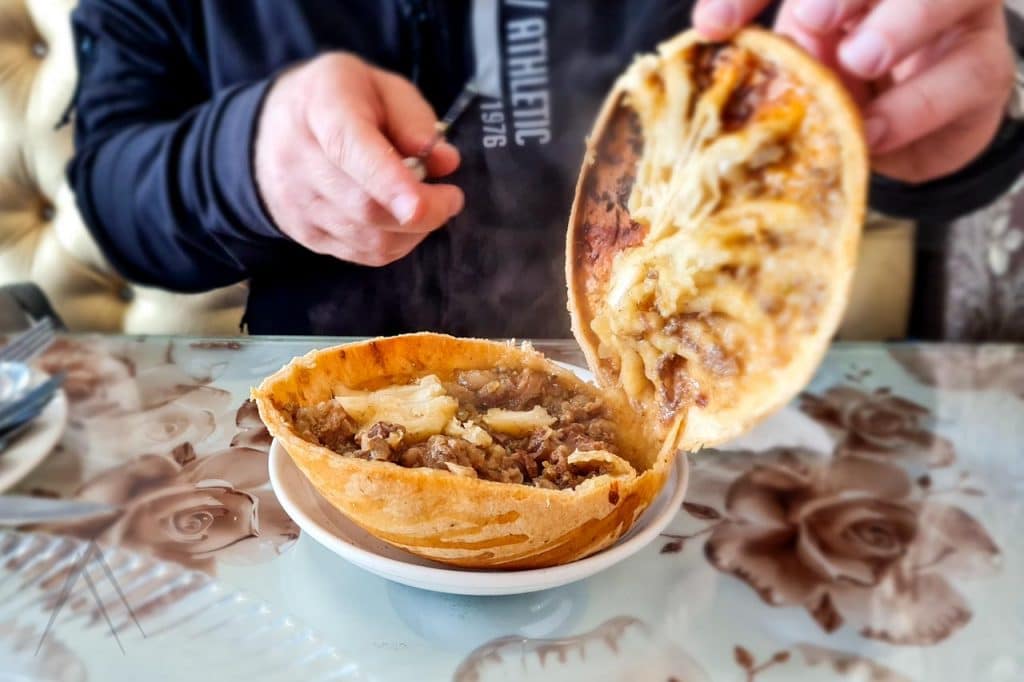
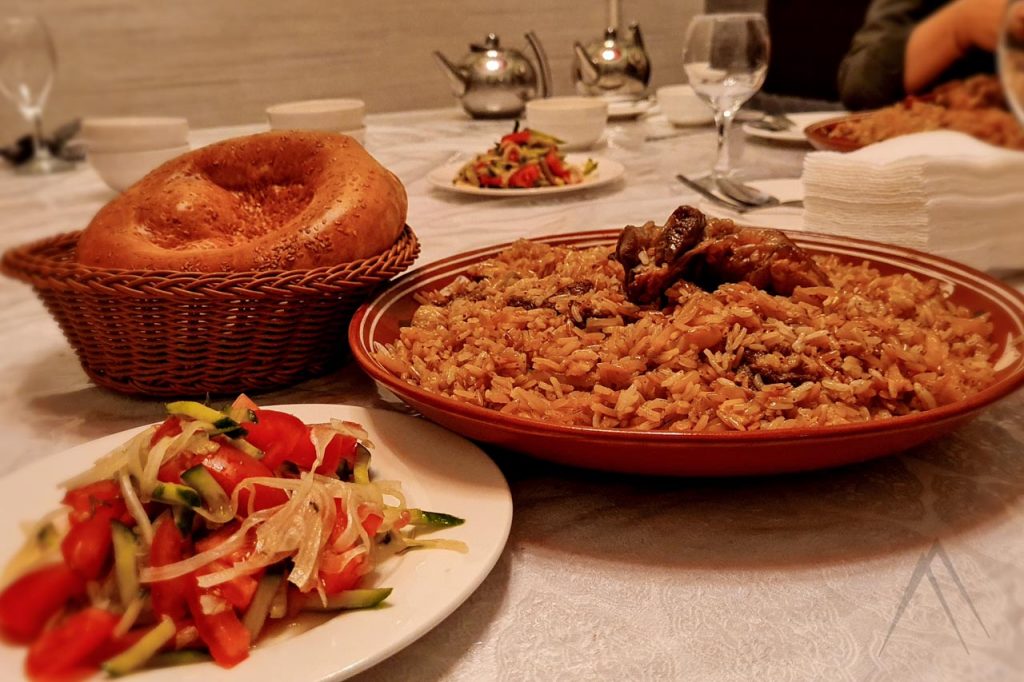
Osh is still best known for the Sulaiman Too mountain which is located almost at the center of the city. According to UNESCO it is the most complete example of a holy mountain in Central Asia. There are several caves with pilgrimage sites at the mountain that you can explore and some remains of very old cultures from very far from the ancient times.
There is also a small prayer room called the Bobur‘s (relative of Temirlane) hut at the very top of the mountain and a nice Soviet made cave museum. Sulaiman Too is a popular destination for muslim pilgrims being one of the top locations for this purpose in Central Asia. Lastly, Osh is a great basecamp to explore the whole Southern Kyrgyzstan.
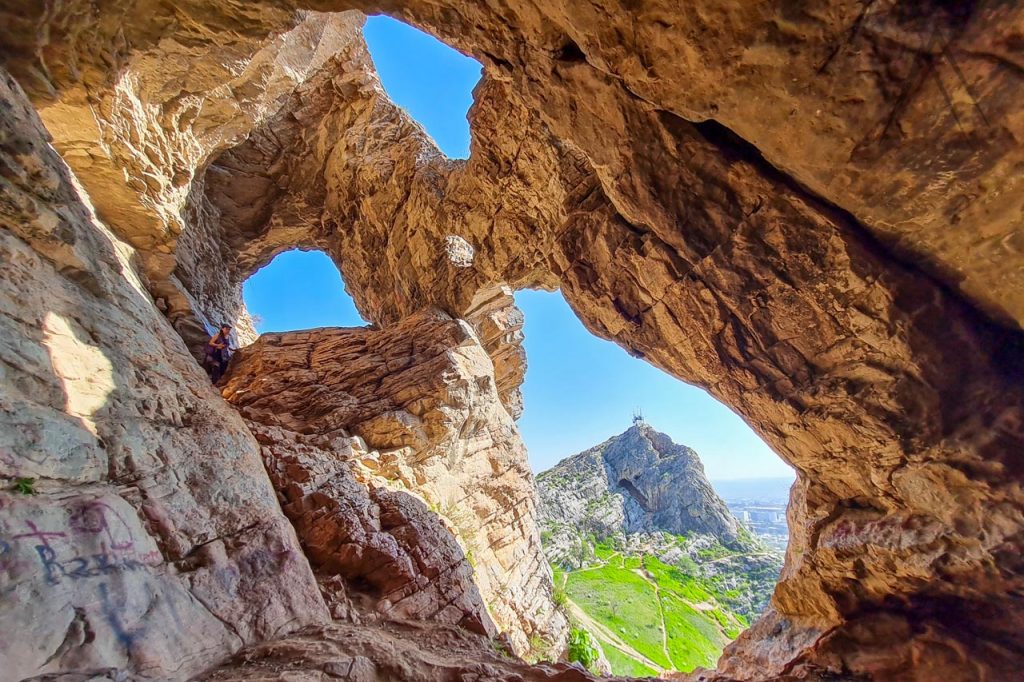
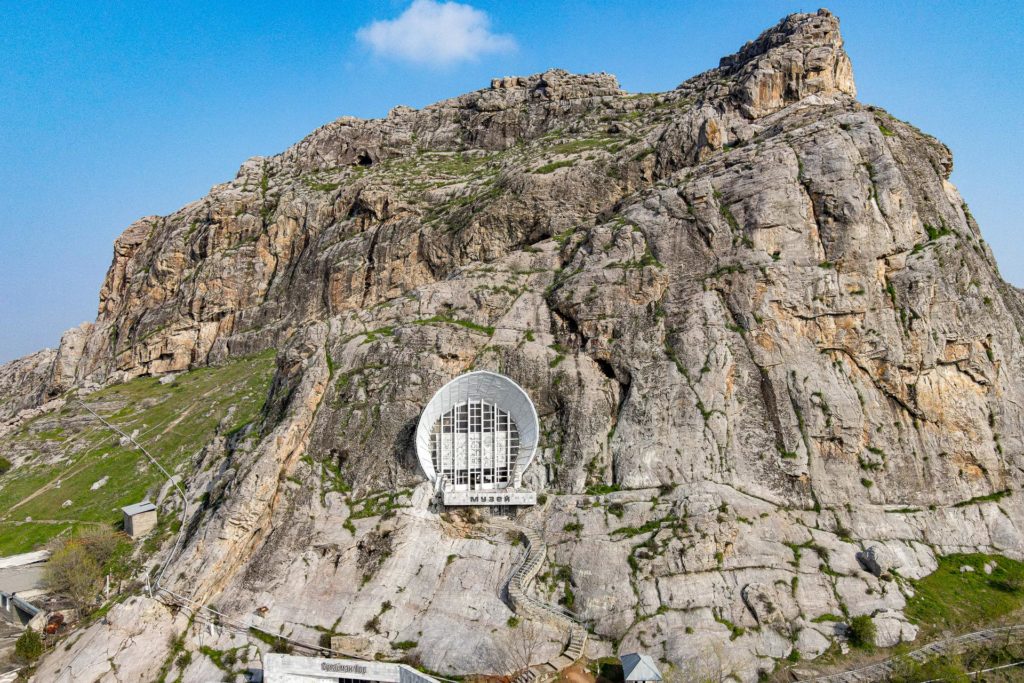
Stay with a local Kyrgyz family in a small village for few days
The best way to learn about a culture has always been staying with the locals. As the majority of Kyrgyz still live in the villages of the rural areas, one could say that the true Kyrgyz culture will be found there. Like in many other nomadic or Asian cultures, hospitality is paramount in Kygyz society as well. Guests are treated with the utmost respect and are showered with treats, stories, merriment and laughter. If you are staying in a yurt, pay attention on where you are seated as the most honored place is always opposite the door in the “back” of the yurt.
The great thing about Kyrgyzstan is that it hasn’t been ruined by mass tourism yet. The locals here are genuinely happy to see foreigners in their country and are extremely eager to please them and to show the best of their country. Don’t be surprised if you are invited to a home for some tee and bread with jam and suddenly find yourself surrounded by very curious people and especially kids even though you might not even have a common language.
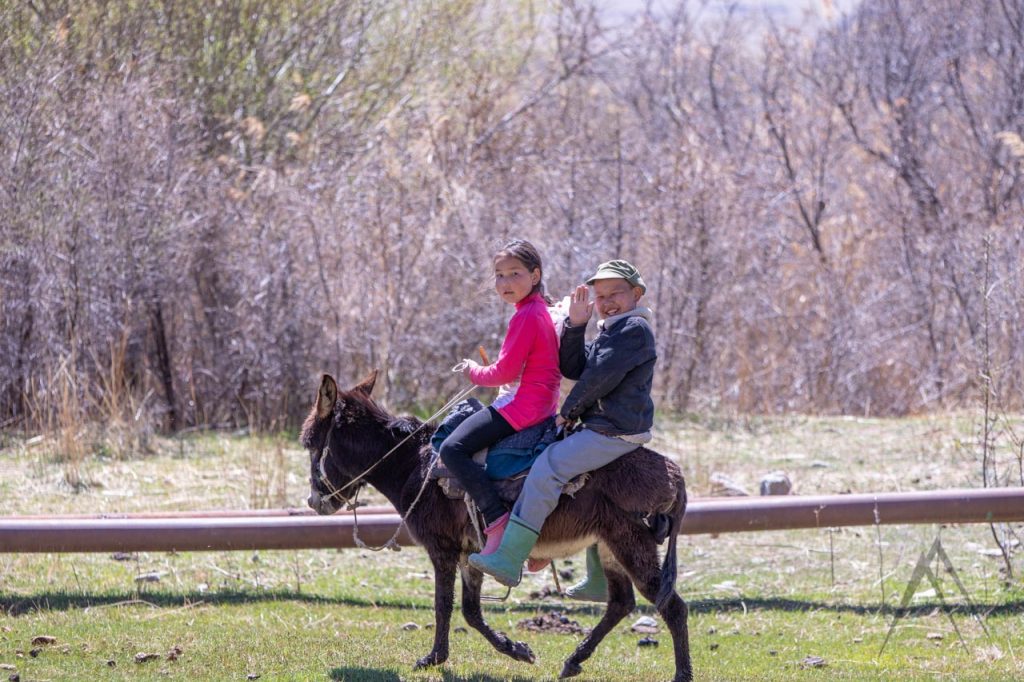
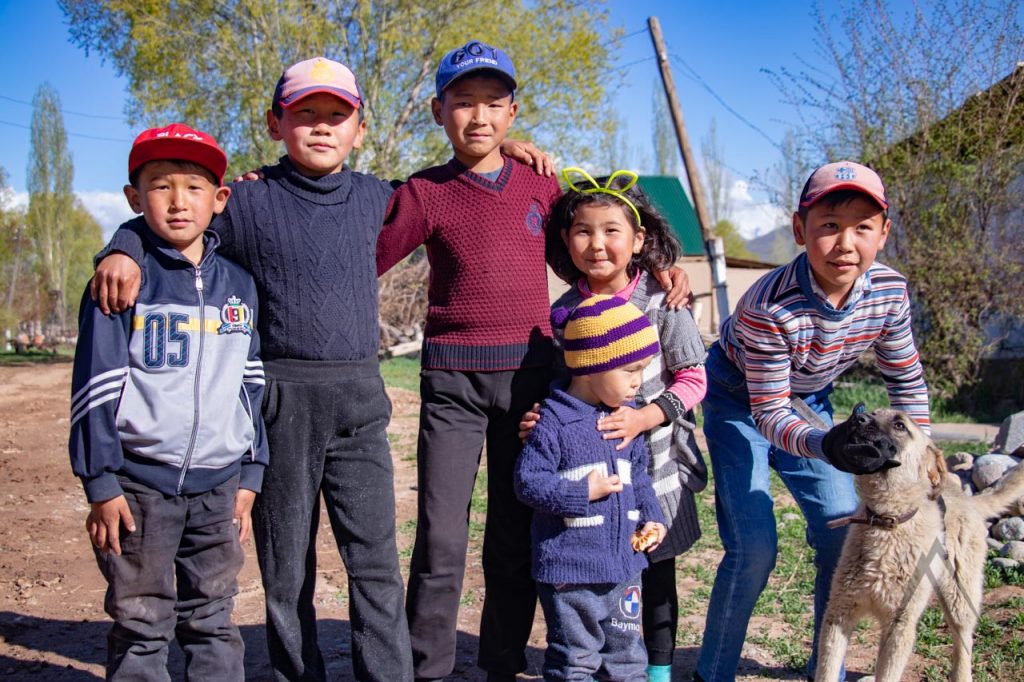
Learn about the Dungan culture in Karakol or Aleksandrovka
Dungan people originate from China and are descendants of muslim Hui people who have emigrated from China to Central Asia mainly in the 19th century with the permission of the Russian Empire. They mostly live in the area around Karakol and just west from Bishkek in Sokuluk (which they call Aleksandrovka according to the Tsar that promised them Russian land.) Their language is very close to Chinese but with some loan words from Arabic, Persian and Turkic and they should not be confused with Uighurs that are of Turkic origin and moved to China from west. The Dungan people in Kyrgyzstan are mostly working with agriculture but recently some families have started to organize Dungan dinners in their homes. Dungan culture could also be described as conservative.
Dungan food is fairly different from Kyrgyz cuisine and one could say that it is a mix of Central Asian and Chinese cuisine. The most significant difference with Chinese food is that as muslim people they do not eat pork. The most famous Dungan food in Kyrgyzstan is the Ashlan Fu. It is a spicy, cold, noodle soup made with two different noodles together with herbs and broth. Ashlan Fu is usually served with a hot, deep fried potato bread which greatly balances the spicy food. Pro Tip: It is a great dish for the day after to get you going again!
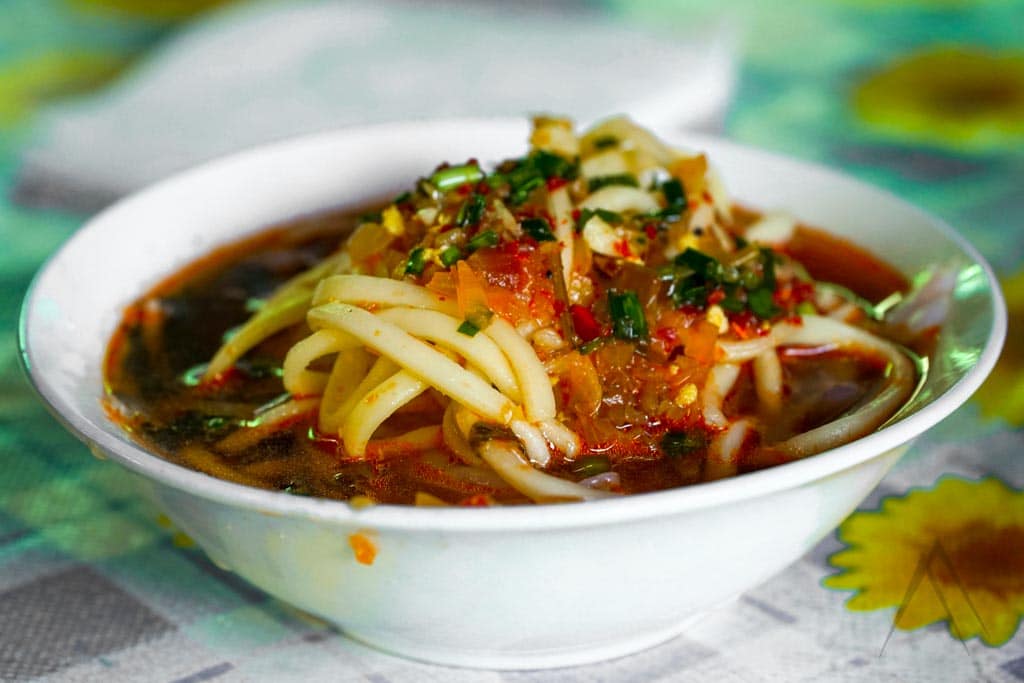
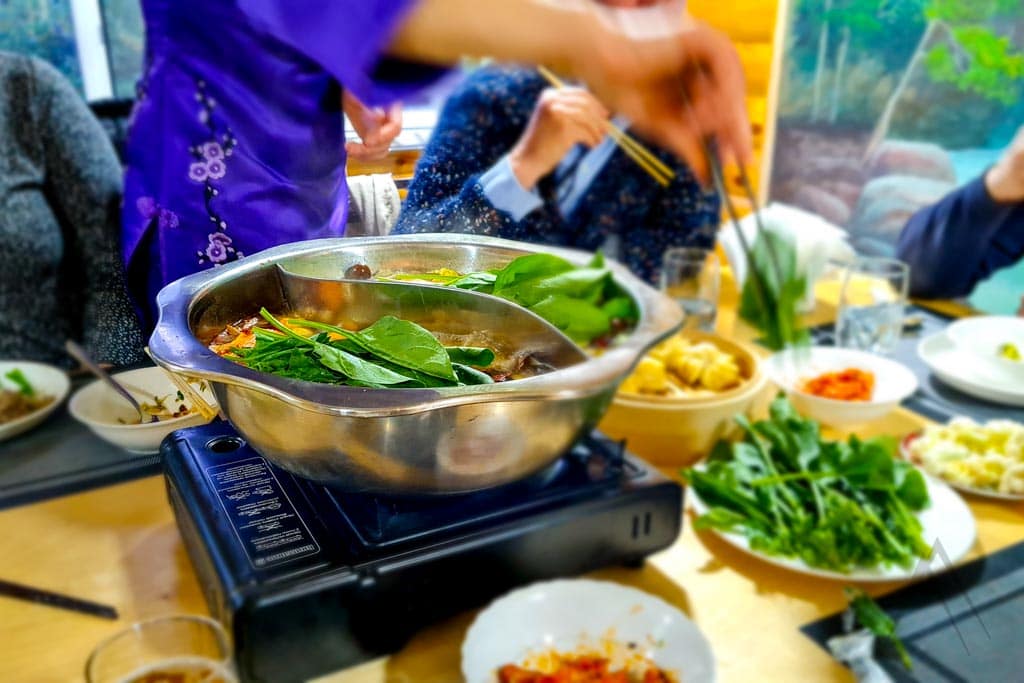
Spend time in the museums of Osh, Bishkek and Cholpon Ata
If museums are your thing, Kyrgyzstan will not leave you cold. Both the State History Museum and the National Museum of Fine Arts in Bishkek present a tough, grey concrete style structure that, at that time, was meant to represent how strong and reliable the government was. The state history museum presents the old Kyrgyz history, alongside the Soviet era with some quite magnificent Soviet memorabilia.
In Osh one can really dig deep in the silk road history and the older parts of the local history in the region. The Osh historical museum together with the nearby Sulaiman Too offer enough to see and experience for a day. In addition, the Osh hitorical museum is a great place to escape the summer heat under its cool marble interiors and exteriors.
Outside the above mentioned museums, one of the most peculiar museums in Kyrgyzstan is the Hertzen museum in Talas region, not far from the border to Kazakhstan. It houses some Soviet art by the father and son that are of German origin and is well worth seeing if you are nearby. There are also several other museums in Kyrgyzstan worth a visit.
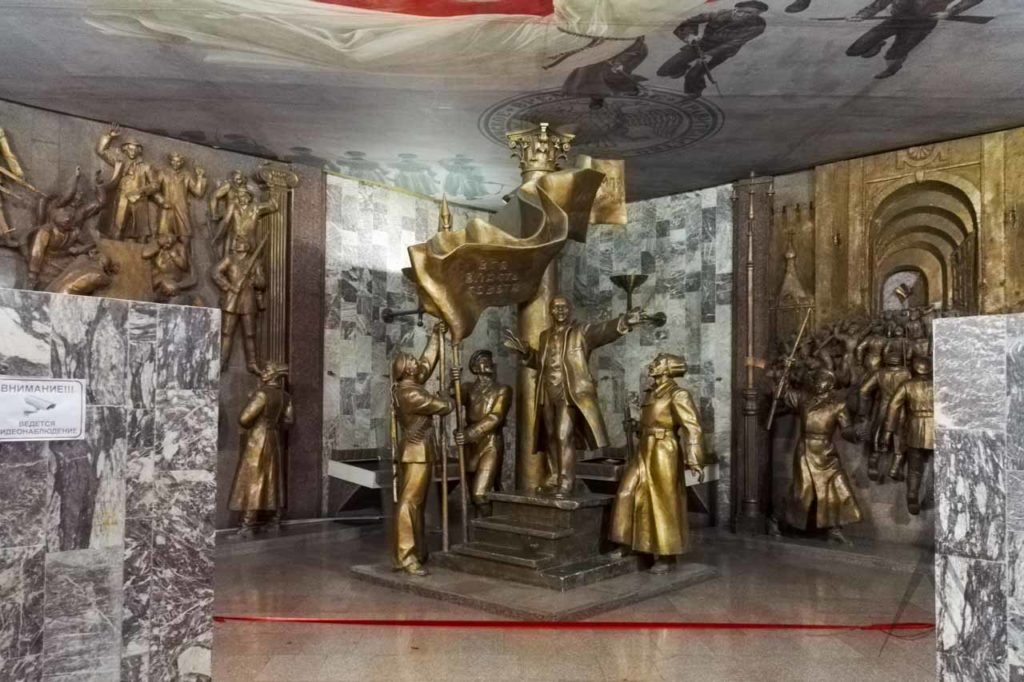
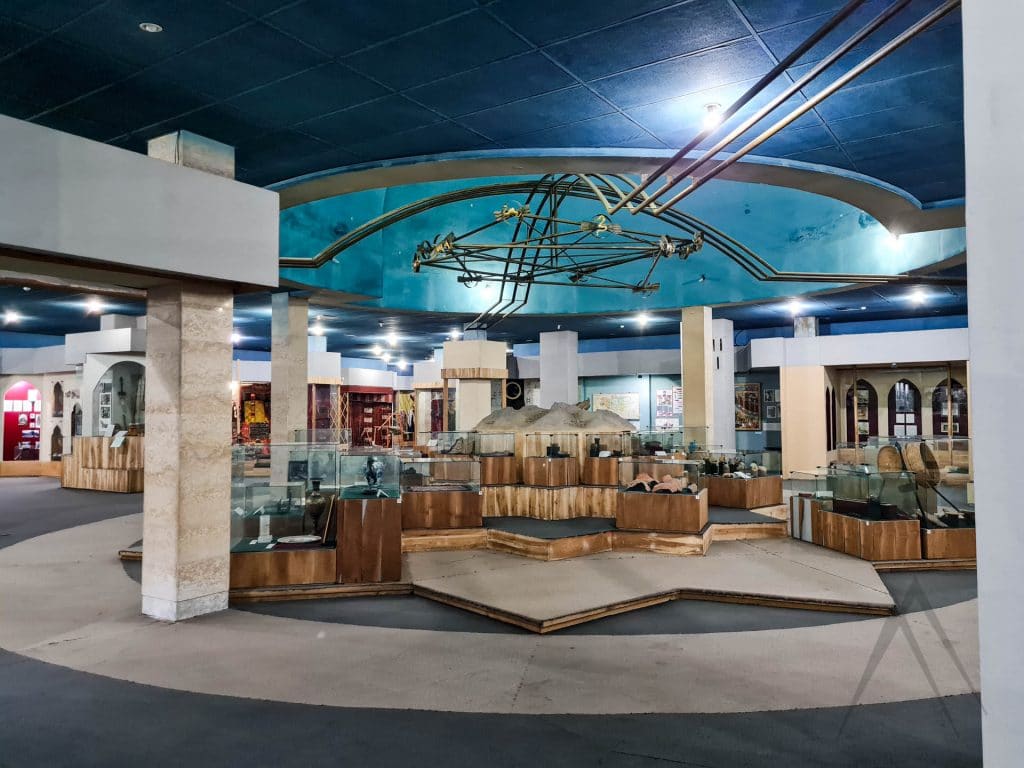
ADventures in Kyrgyzstan
Wander off the beaten path in Batken
Batken region is a thin slice of Kyrgyz territory between the Uzbek Fergana valley and the mountain range separating Kyrgyzstan and Tajikistan from each other. The area has also been somewhat turbulent in the last two decades and especially in 2021 when the armed forces of Tajikistan and Kyrgyzstan were having a short battle over the Vorukh enclave and the surrounding area. There are also other enclaves in the Batken area, where Uzbek soil is trapped inside Kyrgyzstan. The ethnicity of the people in Batken region might also change from village to another between Uzbek and Kyrgyz or even Tajik and it can be easily seen when traveling from one village to another from the way people dress and even how the villages are managed.
But Batken is not totally off limits to tourists and those who actually venture out this far will definitely be rewarded by the secrets of Batken. The area is mostly known of its Aigul flower which allegedly only grows on one mountain side in the whole world near the Kara Bulak village. This flower is really special in appearance and blooms early in the mid April for only one to two weeks. When the relations between the neighbors are good, it is also very interesting to explore the enclaves and the secrets hey hold. Batken also has some medieval historical fortresses from the Kokand Khaganate period that ruled in the area.
Batken also hosts the Pamir – Alay mountain range, which is one of the most spectacular mountain ranges in Kyrgyzstan. The spine of the range, which separates the Batken from the Alay Valley, has many beautiful valleys to hike and explore. There is also an area called the “Kyrgyz Patagonia” where vertical mountain slopes soar up for hundreds of meters like in the Karavshin valley. The area is very popular among mountain climbers due to the excellent conditions.
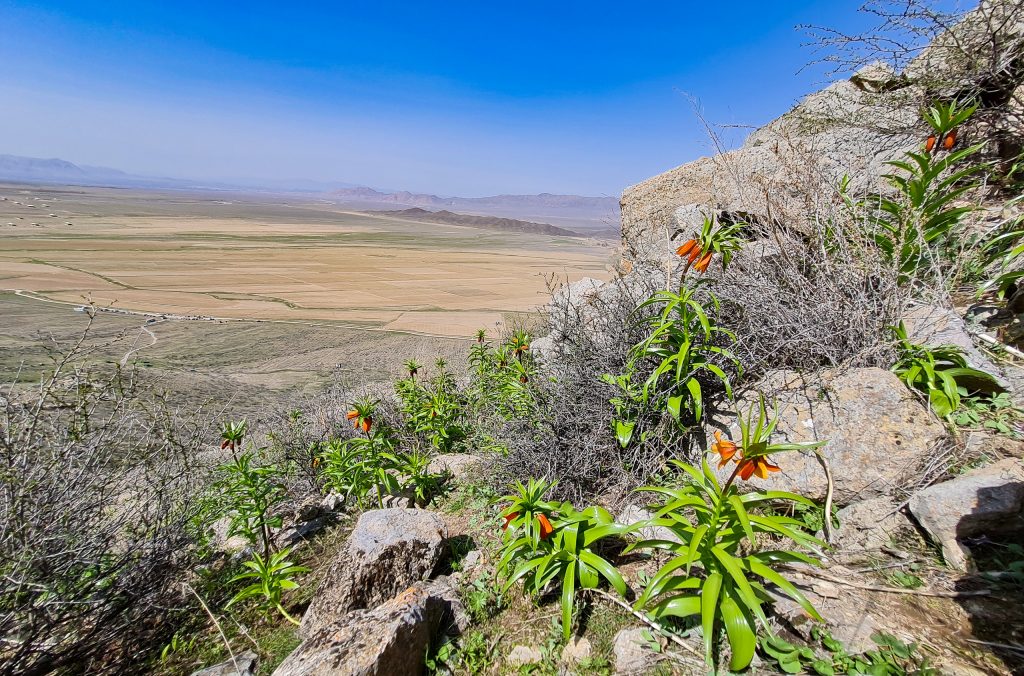

Take a jeep tour around Kyrgyzstan and discover the real hidden gems
As usual, to reach the best destinations in Kyrgyzstan also, requires some effort. The mountain roads around the country are not in the best condition meaning that in order to reach some of the best locations, one must be ready to drive along quite bad roads or even where there are no roads at all. We know that for some of you this is actually an invitation to drive freely and to experience the real off road conditions and in this scene Kyrgyzstan really provides.
There are several high plateaus and valleys where it is possible to drive according to your own plan on the grassy fields without roads like in the Ak-Sai Valley, not far from the Chinese border. Another great option for driving without apparent path is while driving around the Son Kul lake and onwards to Suusamur valley through Kazarman. But before you go, make sure that you have the sufficient driving experience and that you get a good enough car for example the river crossings where there are no bridges available. If you feel insecure about driving in the mountain roads, contact us and we can organize you the wheels and the driver.
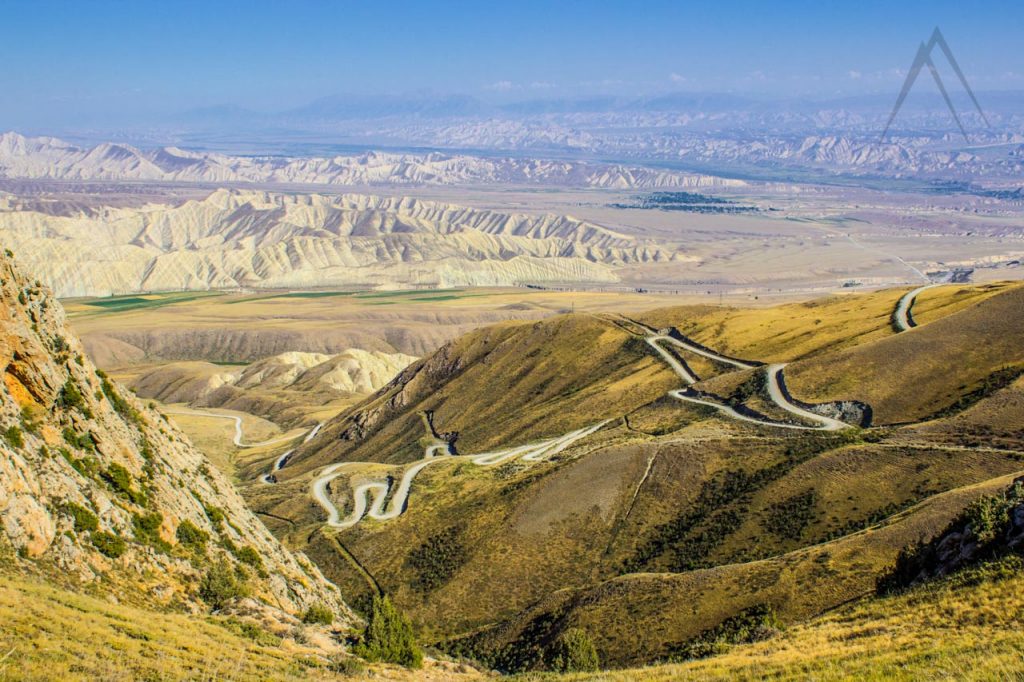
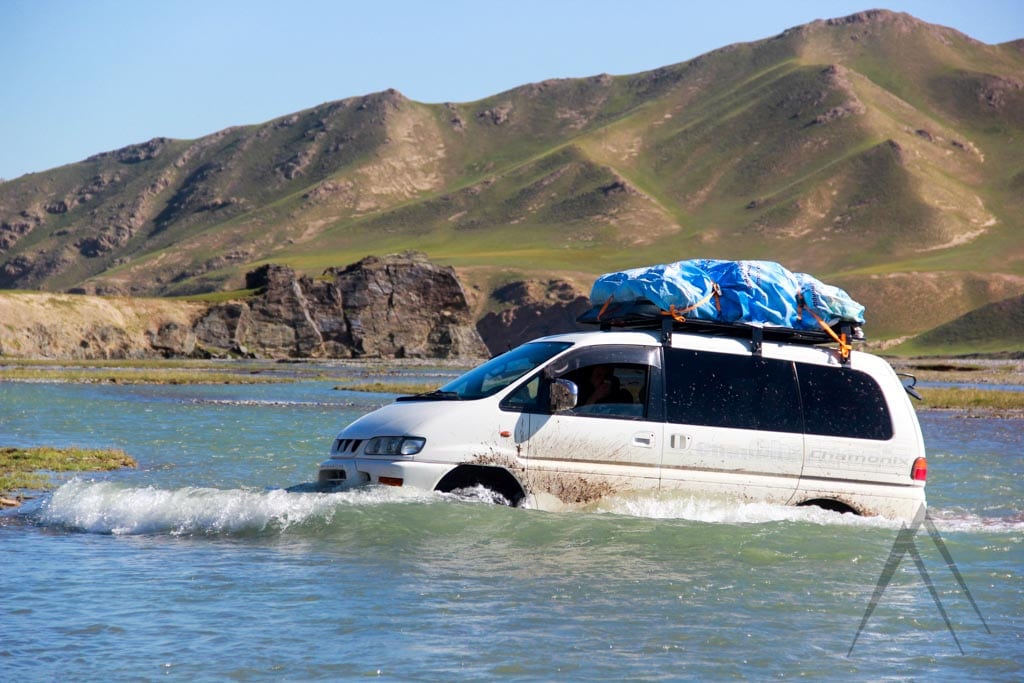
Head towards the Pamir highway and see the Lenin peak & Alai Valley
Ever heard of the Pamir highway? It is the only driveable road through the Pamir mountains in Tajikistan starting east from Dushanbe and ending in the the Alay valley in Kyrgyzstan or the other way around. Alay valley is actually not that much of a valley but a high plateau surrounded by very high mountains like the Lenin peak, which is the second highest mountain in Kyrgyzstan.
Alai valley is also home to an amazing set of small lakes, not far from the base camp to Lenin peak. There are at least 40 small small lakes with greenish clear water surrounded by green hills that feed from the water from the nearby hills. In the western part of the valley there is also an old Silk Road era fortress ruins that for sure is worth to see while visiting. The real thing in Alai valley is still the untouched nature and the hidden gems in the small valleys surrounding the plateau with alpine lakes and rivers and abundant high mountain wildlife.
P.S. In 2021 the border from Alay valley to Tajikistan has been closed due to bad relations between Kyrgyzstan and Tajikistan.

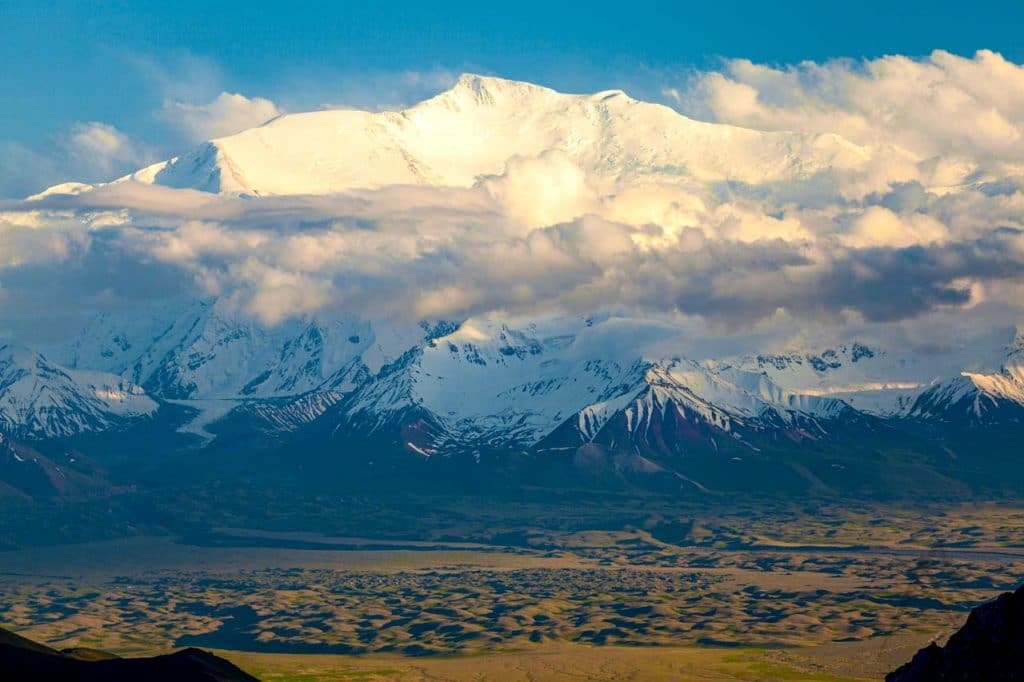
See the beautiful Kyrgyz border zone near China on the way to Kel Suu
Kel Suu lake is one of the most amazing alpine lakes in Kyrgyzstan. It is situated at the altitude of 3500 meters from the sea level and is surrounded by sheer stone cliffs stretching up hundreds of meters. Kel Suu (or officially Kol Tetiri) is located at the border zone that follows the whole Chinese border. In order to get there one must have a border zone permit that will be checked on the way once or twice by the Kyrgyz military personnel. In order to reach Kel Suu you must venture deep to the Kyrgyz heartland and even past it but the road is very beautiful and allows you to see a lot of this beautiful country.

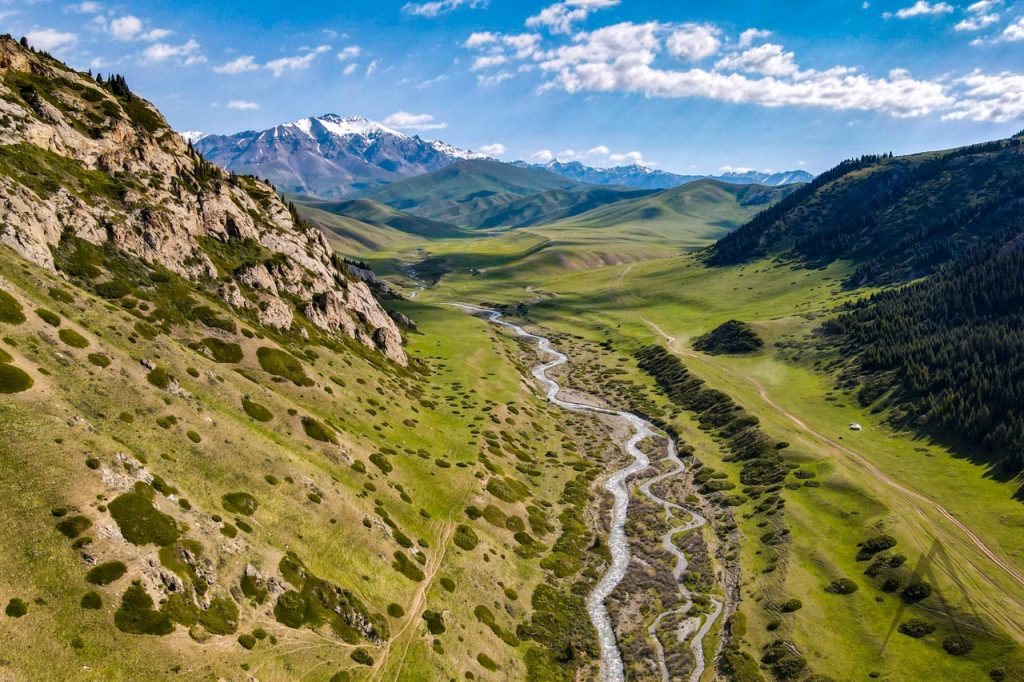
After you have reached Naryn, which is the best base to explore the Eastern Kyrgyzstan, south from Issyk Kul, the road to Kel Suu and China (it is possible to pass through the Torugart pass to China) continues further south passing some true Kyrgyz landscapes with green valleys and mountains and mountain passes everywhere. Before reaching Kel Suu, you will pass the rugged Ak Sai valley from where the waters finally reach the Chinese Taklamakan desert. The whole borderz zone area is very sparsely populated due to the high altitude and there are almost no buildings at all but yurts and some Soviet style mobile homes here and there.
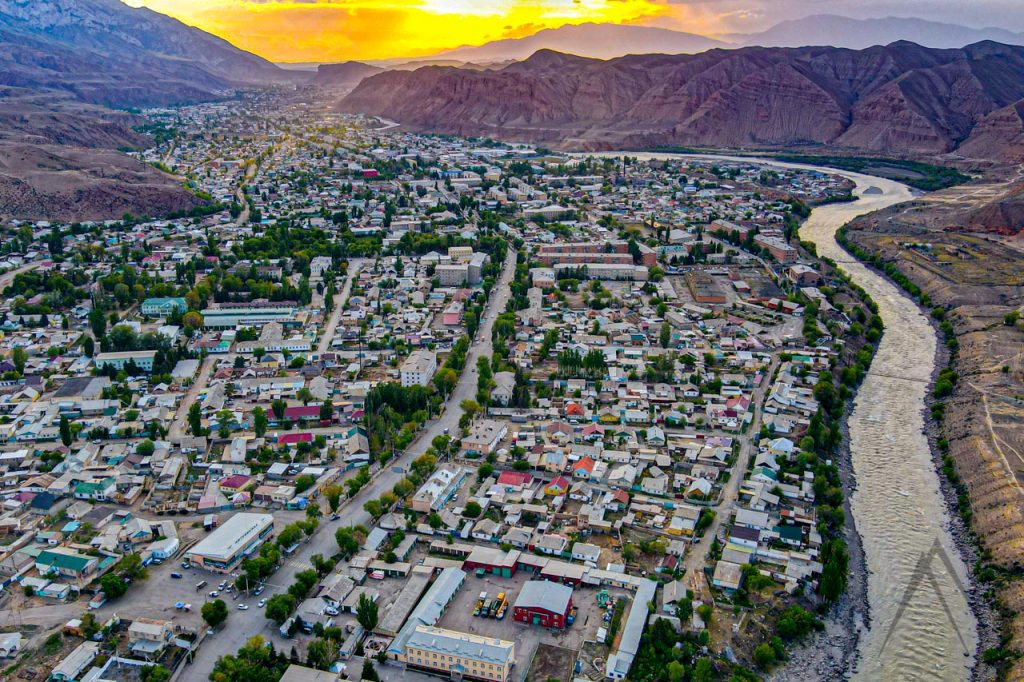
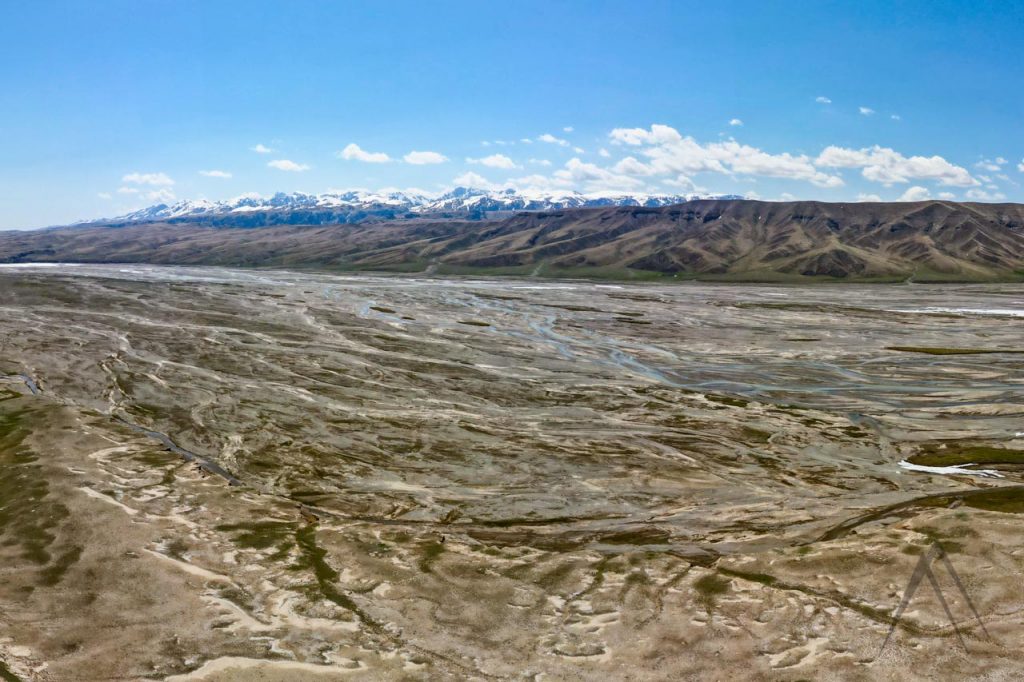
Before reaching Kel Suu you will need to cross a wooden made bridge that crosses a beautiful orange colored rocky canyon that also hides a small waterfall not far from the bridge. The road ends about 8 kilometers before the lake and from there we have three options. Hike to the lake, ride there horseback or drive by rugged 4WD wehicles if the season is correct and the water level in the river flowing from Kel Suu is not too high. Regardless of the choice, the last part of the trip will be amazing among the huge 4 km and more peaks around you with yaks and sheep grazing around you. After finally reaching Kel Suu it is possible to organize a boat trip to explore the lake further too with the hidden caves and mountain meadows!
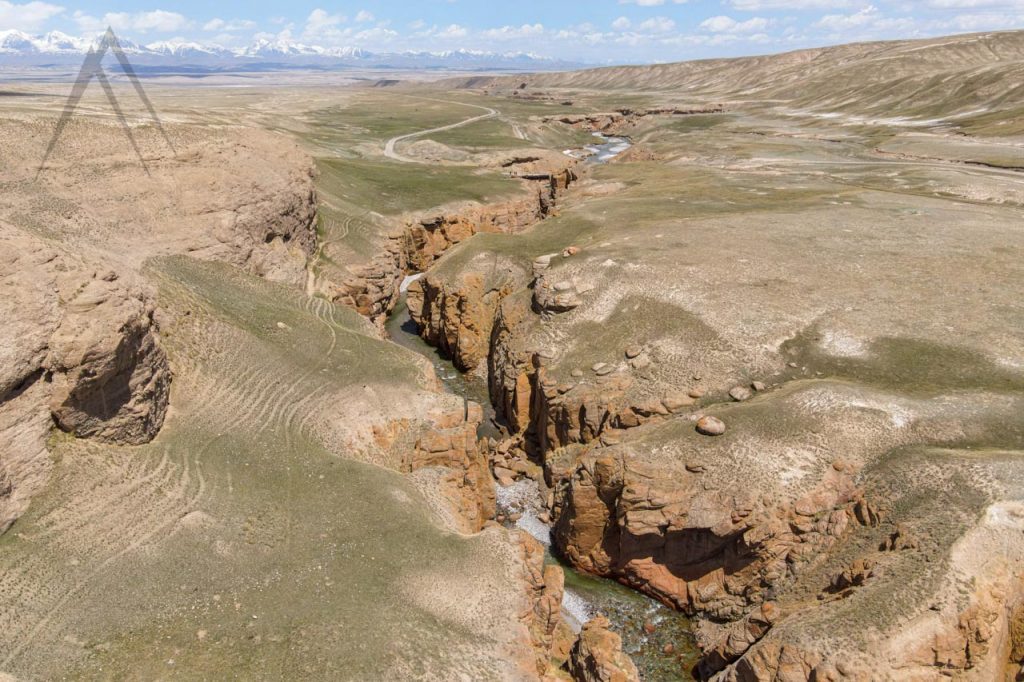

Take a Soviet helicopter ride to Khan Tengri peak
Tien Shan mountains have several peaks with the height of more than 7000 meters. Even though Khan Tengri is not the tallest of them, but only the third in Kyrgyzstan with its 7010 meters, it is one of the most magnificent ones due to its pyramid shape form. Khan Tengri peak is located at the crossing point of the borders of Kyrgyzstan, Kazakhstan and China and is very far from basically everything.
This means that if you are not ready to hike for weeks, it is best to visit the mountain by a helicopter transport! The helicopters can take you to the basecamp of Karkyra and from there you can select different level hikes to see glaciers or even go higher to conquer the peaks. The helicopters and pilots that will take you there, are well suited and experienced with the rugged mountain conditions. Khan Tengri can be also combined with the famous Enylchek glacier and the Mersbacher lake which appears and disappears every year!


Ski in Kyrgyzstan
Being a super mountainous country, it is not a surprise that Kyrgyzstan is an amazing location for skiing. There are several skiing centers for the ones who wish to go down fast after a lift ride up (with huge opportunities for backcountry skiing) but also amazing places for cross country skiing in the snowy mountain valleys and plateaus that become breathtaking beautiful during the winter time. The main areas for skiing in Kyrgyzstan are the Karakol and the mountain slopes just south from Bishkek.
In addition to excellent conditions for any kind of skiing, it is also extremely affordable here. Cottages or lodges in Kyrgyzstan are not yet at the level of European or Northern American standards, but who wants to spend their time in a lodge anyway when you are next to amazing mountains and skiing locations. Equipment and safety equipment are also available for renting. The season for skiing in Kyrgyzstan is from November till April but can vary a lot from year to year as the snowing can be very scattered and capricious here.
Want even more adventure? Kyrgyzstan is really the place for heli skiing and you can be sure to find your own powder heaven. In Jyrgalan it is also possible to have snow cat ride for your chosen private location. By the way, if you are not a fan of skiing, you can still enjoy Kyrgyzstan with snow shoes, snow mobile, horseback riding in the snow or even ice skating on top of the extremely clear ice of an alpine lake.
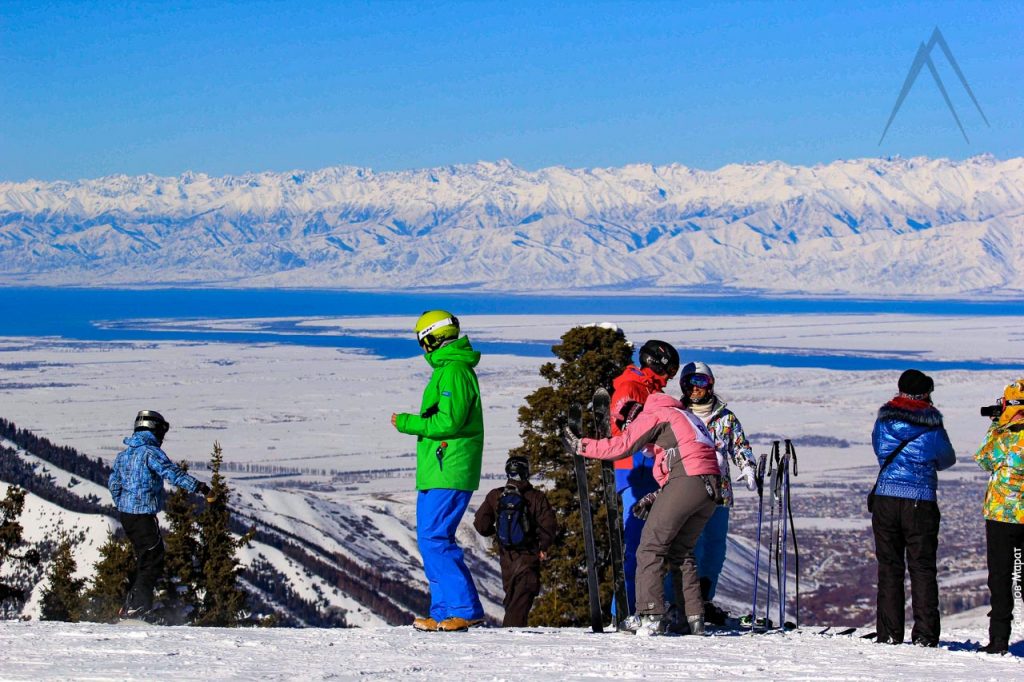
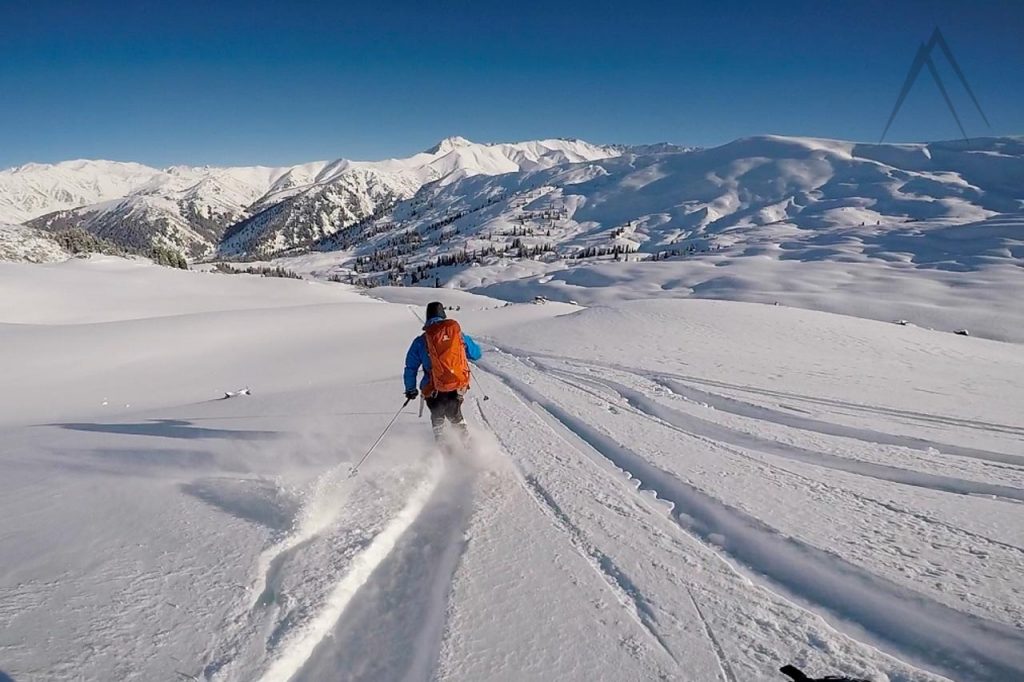
Become amazed by the Kyrgyz mountain nature
Join Kyrgyz fauna and flora photograph tour
What makes Kyrgyzstan’s fauna and flora so amazing is the fact that there are so many different kind of landscapes and height levels making the nature incredibly varying. There are lush forests, dry high altitude steppes, mountains and even higher mountains with beautiful meadows and the tien shan spruces make the steep mountain slopes so green and you can even find deserts and semi deserts here. There are hundreds of different species of plants growing in Kyrgyzstan and a lot of them have been used for ages for medicinal purposes. They also include several endemic and extremely rare plants.
Kyrgyzstan’s fauna includes large mammals like bears, wolves, wild boars and several different mountain adapted goats and wild sheep like the Markhor and the Marco Polo sheep and several half or fully domesticated animals like yaks. There are also a lot of birds of prey with eagles and large vultures especially in the higher remote areas and many ornitologists come here to see the rare ones that are missing from their list. The most famous animal of Kyrgyzstan is the snow leopard but it is extremely hard to see it as it eludes people and lives only in the most remote areas of Kyrgyzstan.
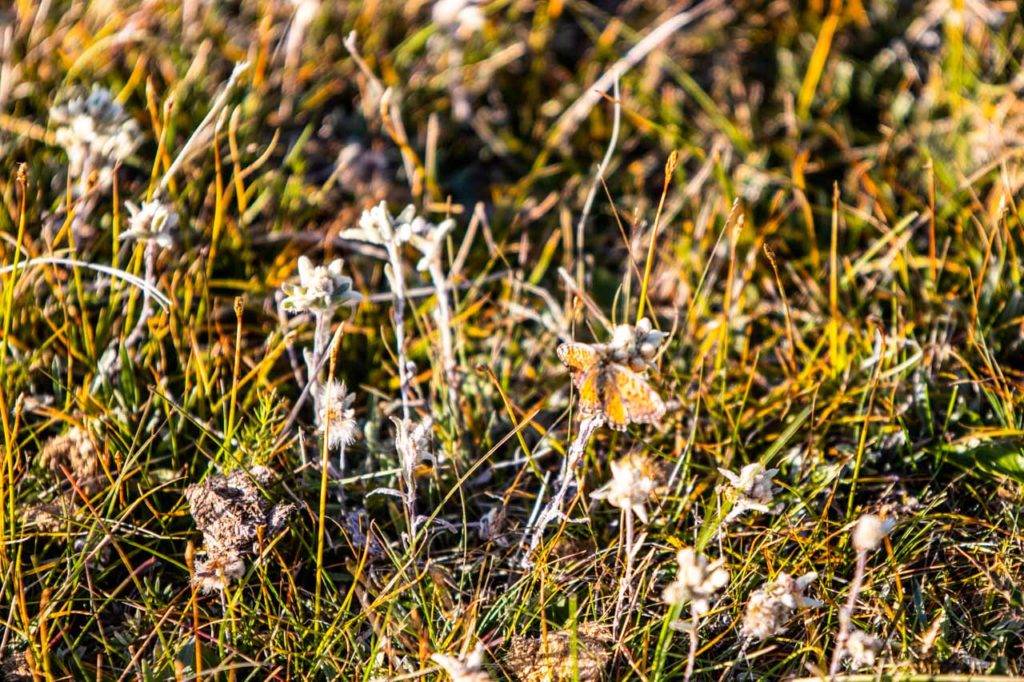

Collect walnuts in the world's largest natural walnut forest
Arslanbob in the Southern Kyrgyzstan is the home for the world’s largest natural walnut forest next to the amazing carstic mountains of the Chatkal range, that provide the location a very special micro climate and soil properties making it a perfect site for the walnut trees. Some legends even suggest that this would be the original home of the walnuts from where they spread around the world together with Alexander the great.
For the residents of the villages surrounding the forest, the walnut forest provides income as during the autumn people spend most of their time in the woods for days at a time in order to harvest the nuts. The trees are so valuable that it is forbidden to cut them even though there is no other fuel available in the region but wood.
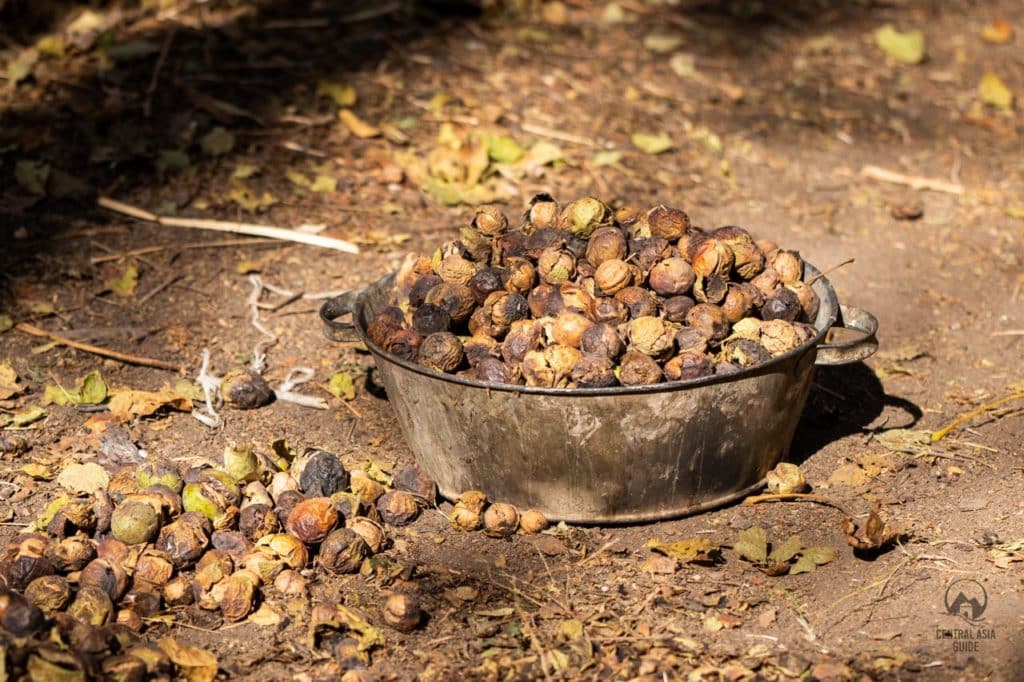
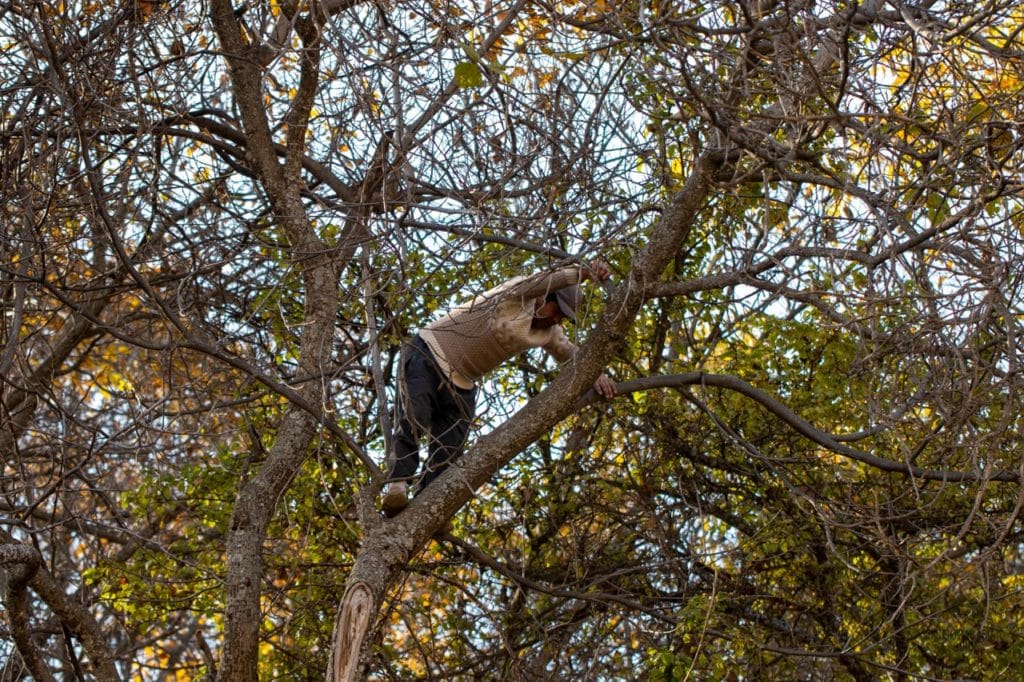
Plan your trips around late-September and October to catch this yearly time of hard work and celebration in Arslanbob. During this about 1-2 month period, the life of the whole region is circling around the walnuts of Arslanbob forests and during autumn time they even might use walnuts as cash in the the local shops when kids buy sweets with few nuts in the local stores.
In addition to walnut forests, there are also two very beautiful waterfalls to be seen in the Arslanbob area. It is also a place where the Uzbek and Kyrgyz cultures have and are still being mixed into something new.
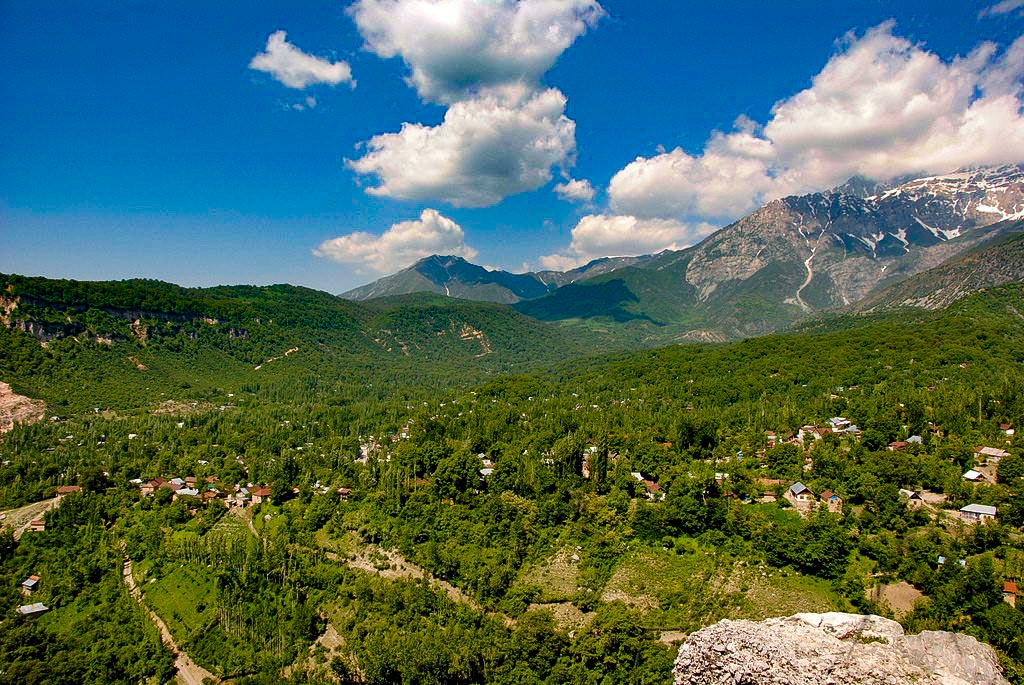

Best tours in Kyrgyzstan
If you have read the story until the end, we are sure that you are already waiting to come to Kyrgyzstan and might be wondering how to see all your favorite things mentioned above. We have a solution: Start by taking one of our tours that are designed together with the best local guides and tour operators in order to organize you the best possible experience while exploring the amazing Kyrgyzstan. If you do not find a suitable tour from our selection, please contact us to organize a private customized tour.